Travel Log of "Seven Wonders of the World" | Read more at in70mm.com The 70mm Newsletter |
| Written by: Richard J. Pietschmann, Sound engineer in field. Retyped for in70mm.com by: Frank Aston (England), Brian Guckian (Ireland), Anders M. Olsson (Sweden) | Date: 30.09.2011 |
 Richard J. Pietschmann, Sound engineer in field.
During the last war Dick Pietschmann was an instructor in the A.A.F.
Technical Training Command and an electronic equipment tester for the
Navy. As sound recordist for RCA Victor he became interested in motion
picture sound production. Then he joined 20th Century-Fox Corporation,
Movietone News Division, as Assistant to Chief Sound Engineer. In 1951,
he accepted the opportunity to join Cinerama Production Corporation.
Source: Cinerama Richard J. Pietschmann, Sound engineer in field.
During the last war Dick Pietschmann was an instructor in the A.A.F.
Technical Training Command and an electronic equipment tester for the
Navy. As sound recordist for RCA Victor he became interested in motion
picture sound production. Then he joined 20th Century-Fox Corporation,
Movietone News Division, as Assistant to Chief Sound Engineer. In 1951,
he accepted the opportunity to join Cinerama Production Corporation.
Source: CineramaSept 6,1954 Labor Day Sept 7,1954 Conference with Walter Thompson etc., at New York Office. Given proposed itinerary dated Sept 2, 1954. Date of departure set for Sept 12 or 13, 1954. It was stated that crew would be covered by blanket insurance issued by Lloyd's of London. Spoke to Walter Thompson re 1/4" Ampex and he gave his O.K. to take same. Discussed Oyster Bay activity after production work is finished. He stated that I would do the Pre-mix and dubbing of the finished product, music scoring, sound effects etc.. My salary to remain the same for overseas and domestic production. Sept 12,1954 Spent today with Mona and boys. We had dinner out and left for Idlewild Airport at 4:30 PM; arriving at the airport at 5:15 PM. Secured tickets etc and plane left ground at 7:15 PM. Our ship is a DC6B and very fast. Estimated flying time to Prestwick, Scotland 9 hours and 44 min non-stop at an altitude of 20,000 ft. Arrived in Scotland 5:30 AM New York time, 10:30 AM English time, there being a five hour difference. Sept 13, 1954 Proceeded from Prestwick Airport to the city of Glasgow by bus which took an hour to arrive. We were obliged to stay here until 3:40 PM to secure a flight to London. Had a typical lunch of roast beef which was not too good and spent the time wandering about the city viewing the sights. The city does not compare with Edinburgh. Glasgow itself is clean but the use of soft coal for heat and industry ladens the atmosphere with a heavy pall of smoke. Left Glasgow at 4:00 PM for London via BEA and arrived 5:30 PM. Our hotel is located near North Croyden about 15 miles from London and it took 3 cabbies over 1 1/2 hours to drive there and find it. | More in 70mm reading: Letters Sent Home - supplement to log of "Seven Wonders of the World" in70mm.com's Cinerama page Historic Big Screen Films Get Major Digital Makeover Internet link: |
|
Sept 14, 1954 Last night was spent at the Selsdon Park Hotel, located about 15 mi. from London. The bed was comfortable and I had a good nights rest. The hotel was in a very nice setting, situated among beautiful trees and gardens, with its own golf course. Some of the original buildings date back to 861. We left there about 10:30 AM and proceeded to Paddington Station in London where we were to get a 1:55 PM train to Cardiff, Wales. Saw Fred Bosch, Mal Miller and Bob Heissler while waiting for the train. The technical equipment is still in Dover, England and has not as yet cleared customs. Had lunch in the Park Lane Hotel in London and met Gregory Ratoff, a Hollywood director. I worked with him on a picture in New York while still with Fox. Left London on schedule and arrived in Cardiff without incident. We are staying at the Park Hotel in Cardiff. It is very ancient but clean and comfortable. Were informed that the trucks may arrive in Cardiff tomorrow afternoon. Had dinner, which was fair. At its best, English cooking is not too good, and the portions are small. After dinner we went to a movie and saw an English picture called
"The Seekers", a story of the colonization of
New Zealand. After the movie went back to the hotel and to bed. | |
 Sept 15, 1954 Today we were scheduled to start production, but have no equipment. After breakfast went and inspected the hall where I am going to record the Welsh Festival Choir under the direction of John Morgan Nicholas. He is a very small man in stature but quite pompous and must get a big kick out of directing a choir of 150 welshmen and women. After visiting the hall, I wandered around the town of Cardiff which is a principal coal and steel center. The people are very plain and not as large as I expected them to be. I also walked around the Cardiff Castle grounds. The remnant of the original castle is still there surrounded by a moat and dates back to the Romans. I did not go inside the castle but plan to do so some other day. Most of the time the weather is cloudy with lots of rain. I have been told that the past summer had 60 or more days of rain this year which is a lot, even for England. This afternoon I was advised that the trucks still had not cleared customs and probably would not be here until Friday. Somebody "goofed". Fred and Tom Conroy are handling this and must be having a lot of trouble. After dinner Ted Tetzloff and I went to a rehearsal of the choir and then went back to the hotel. Had a nightcap of two glasses of Guiness's Stout and so to bed. Sept 15, 1954 Today we were scheduled to start production, but have no equipment. After breakfast went and inspected the hall where I am going to record the Welsh Festival Choir under the direction of John Morgan Nicholas. He is a very small man in stature but quite pompous and must get a big kick out of directing a choir of 150 welshmen and women. After visiting the hall, I wandered around the town of Cardiff which is a principal coal and steel center. The people are very plain and not as large as I expected them to be. I also walked around the Cardiff Castle grounds. The remnant of the original castle is still there surrounded by a moat and dates back to the Romans. I did not go inside the castle but plan to do so some other day. Most of the time the weather is cloudy with lots of rain. I have been told that the past summer had 60 or more days of rain this year which is a lot, even for England. This afternoon I was advised that the trucks still had not cleared customs and probably would not be here until Friday. Somebody "goofed". Fred and Tom Conroy are handling this and must be having a lot of trouble. After dinner Ted Tetzloff and I went to a rehearsal of the choir and then went back to the hotel. Had a nightcap of two glasses of Guiness's Stout and so to bed.Sept 16 to 27 The log of this trip has been delayed for various reasons mainly due to press of work and traveling. Tuesday Sept. 16 was spent in the City of Cardiff Wales awaiting equipment which was in London. In the evening the director, Myston Thomas and myself attended a rehearsal of the Welsh Festival Choir. Sept 16, Thursday Were advised this AM that the equipment would not arrive until 12 noon. It finally arrived at 2:00 pm, but WITHOUT THE GENERATOR which is our source of 60 cycle power. The director had booked the Choir to be recorded at 7:00 pm. Since the generator had not arrived we were unable to furnish our own power, so some method had to be devised to operate on the local power which is 3 phase, 440 volts, 50 cycle. I contacted the local electrical authorities and a method was devised to drop the power to 220 volt (our operating voltage) but we could do nothing about the 50 cycle frequency. However this can be overcome in New York in the re-recording process. At 7:30 pm we were ready for recording and worked until 10:pm The director had asked me to do what ever I could to save the situation and it was by this method. We had the basic music which later could be matched to the picture, although sync playback is not possible, using the big channel. Friday Sept 17 Nothing of importance today. Outdoor shooting was scheduled but rain held us up. Sept 18 Sat Shooting in Cardiff castle is scheduled to 2 pm but without sound. I tried my best to get the director to shoot sound but he insisted that he could not use any. He stated that this shot would be matched to the choir recording. I explained to him that the success of this process is to shoot as much sound as possible in order that the perspective illusion of camera to sound be maintained. He expressed appreciation of this fact but I do not think he is aware of the problem. All I can do is to advise and give the benefit of my experience. From that point on the question is up to him. Several silent shots were made. Sept 19 Sun Today dawned beautifully and at 8;30 am the crew was on its way to Tintern Abby, an ancient ruin which was started in the 12 century by a monastic order which desired to "contemplate God in peace and comfort" far from the civilization of man. Today only portions of the main walls are standing. This shot was made with sound, since a group of women were singing. Later we returned to Cardiff Castle and made one exterior silent shot. | |
|
Mon. Sept 20 This Am we rode to Carphilly Castle and made several silent shots of the castle, town etc. with people singing. The director did not want to use sound. I do not intend to dispute the point, but after my previous discussion with him, I think that his thinking is not in terms of Cinerama. We moved to another location, high on a hill overlooking the town and made another silent shot, then moved to a cottage location with two people in the shot. I convinced the director that we should make sound and he agreed. We set up the equipment between rain showers, covering the open mics several times to protect them from rain. As soon as the sun was out the director wanted to shoot and I requested a few minutes to set the mics, such work being interrupted by the rain. He blew his stack and asked why the mics had not been set. The resulting conversations did not help to cement good relationships since I told him that it was unreasonable to expect me to set up the equipment in the pouring rain. The camera was not blimped because they had forgotten to bring the blimp in the truck. The sound for this shot is not useable. I informed the director and he said that it be used as a scratch track. Sept 21 etc. I have not been able to keep this log in very good order from Sept 21 to 29. Several more days were spent in shooting in and around Cardiff Wales. The material was not too good or of very much interest. The crew was to have left for Paris, France but the routing was changed and on Sept 23 we left Cardiff for Cairo Egypt via London and Rome. Stayed in London overnight and the next day, Sept 24 left London with Harry, Jack, Ted T. and daughter. The balance of the crew remained in London to prepare for shipment of the equipment by plane to Cairo. We are sending the trucks home and expect to pick up our P.A.A. charter plane in Cairo. Arrived in Cairo 3:30 am on the 25 sept and cleared customs in short order. We had reservations in a good hotel, the Semiramas Hotel. The room I had with Priestly was large and comfortable with a bath and shower and not too expensive. Enjoyed a day or two of rest awaiting the arrival of equipment and crew from London. Had a chance to look around the city and took some 16mm pictures with the Bolex. Finally the equipment arrived with the exception of the blimp which is necessary to make sync sound. While in Cairo we made some shots of the city and the Pyramids and Sphinx. I also took some pictures of these, with my 16mm on Sept 28-9. On the 29th, the camera crew went to Alexandria to photograph the site of an ancient lighthouse. We also took an air trip to Luxor, Egypt, near the valley of the Kings, and photographed the Kornak Ruins, also photographed the Luxor Temple which is another Ruin about 15 miles away. The upper Nile River consists of the blue and white Nile Rivers. It is in flood at this time of the year, and comes from the Anglo-Egyptian Sudan and Ethiopia. Luxor is about 600 miles from Cairo and is more or less an Oasis in the middle of an immense desert. The land is sectioned by irrigation ditches and the most primitive methods are used for farming - working the soil and carrying of water, etc. There is very little cattle but plenty of goats, water buffalo, mules and jackasses. The chickens are very small and lay tiny eggs, smaller even than a pullets egg, and there are no pigs. These people do not eat pork. Our chartered plane is a PAA DC4 piloted by Capt Dick Conners, Co-pilot John Bateman, navigator Ed Sipple and Steward Patrick Hogan. They all come from New York and Long Island. I am keeping a log of Cities and distances covered in the various flights. This will come in handy later when I trace the route on a navigational map that I am going to get from the U.S. Dept of Commerce. | |
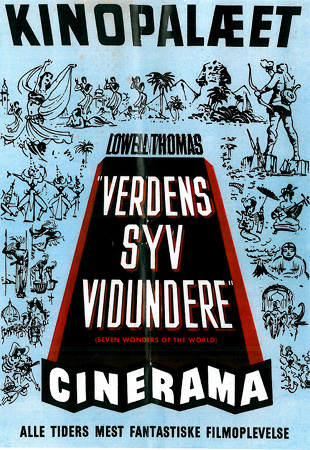 Oct 1, 1954 This morning we took off early and flew from Cairo to Damascus. The flight took about three hours. The director stated that he wanted to shoot without sound. Several shots were made of the city and the
Cinerama exhibit, all done in a great hurry. The sound crew waited at the airport for the return of the Camera crew. Took off, having seen very little of the city, at about 2:00 pm for the return trip to Cairo. (Editors note- Mr Perry phoned and said that he met Dick in Cairo and told them the fair was closing Oct 2, which nobody seemed to know) Oct 1, 1954 This morning we took off early and flew from Cairo to Damascus. The flight took about three hours. The director stated that he wanted to shoot without sound. Several shots were made of the city and the
Cinerama exhibit, all done in a great hurry. The sound crew waited at the airport for the return of the Camera crew. Took off, having seen very little of the city, at about 2:00 pm for the return trip to Cairo. (Editors note- Mr Perry phoned and said that he met Dick in Cairo and told them the fair was closing Oct 2, which nobody seemed to know)Oct 2, 1954 Early this morning we took off for the Belgian Congo. Our plane destination was the town of Juba in the Anglo- Egyptian Sudan. The trip took about eight hours over an immense area of desert marsh and jungle. Arrived in Juba at 3:00 pm. Cleared customs and immigration and proceeded to the Juba Hotel. Took a walk around town and saw my first native Africans. They are black as coal. Some have their front teeth filed to a point, and most all have tatoo marks on their faces and bodies- different tatoos signifying different tribes. Almost all were fully clothed. Some of the women had bare breasts but otherwise were fully covered. However I did see some men walking around the street completely naked which was as unusual sight to say the least. Returned to the hotel and had supper and went to bed. Oct 3, 1954 This morning we unloaded the plane of equipment and reloaded on big trucks in preparation for moving to the town of Aba, which is about 225 KM from Juba. We finally left Juba at about 2:30 PM and drove in the trucks for over eight hours to Aba which is about 75 KM from the Belgian Government controlled Elephant School. The trip to Aba was without incident. The crew, with the exception of the director and daughter, rode in the trucks and it was a most tiring ride. We had no seats except what could be improvised. During the whole trip I did not see a wild animal except some owls. Arrived in Aba about 10 PM and had dinner at the Shaun Hotel. The place was a dump as far as sleeping was concerned but everyone was so tired we did not give a damn. Oct 4, 1954 This morning preparations were made to continue our trip to the Elephant School. Customs clearance was necessary for crew and equipment and we finally started about 12:30 PM. While waiting for clearance, we wandered around town. Aba is somewhat similar to Juba. However the natives of the Belgian Congo are much better specimens than the population of the Sudan. They are better built and appear to be better fed. The Shaun Hotel is in the African Jungle and it is dangerous to wander about at night because of wild animals. The trip to the Elephant School was made by automobile. The drive to the Elephant school took about 2 1/2 hours. We passed many native villages made of bamboo with grass roofs, but during the entire journey we did not see a wild animal. The natives are for the most part, very friendly, wanting to sell us their tomatoes melons and sundry vegetables. All were dressed, and many times the grass skirts of the women conflicted with the modern shirts and walking shorts of the men. Most of the children were naked, but all the girls wore grass coverings of the front and rear and there is much evidence of modesty. Along the road we passed many schools of Catholic Missions and it was surprising to hear so many natives, including children, holding a conversation in English ! | |
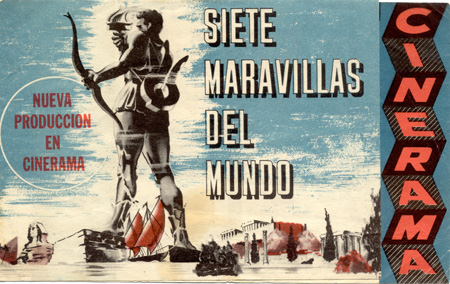 "Seven
Wonders of the World" playbill
from Brasil "Seven
Wonders of the World" playbill
from BrasilAs we drove into the Elephant School entrance, I saw a squirrel, the first animal life since our arrival in the Congo. The road to the school site had enclosed pastures and we saw a few tame zebras, then finally a female elephant with two young ones, all tame, walking about the camp enclosure. We stayed around the camp for several hours and at 6:pm left for the return trip to Juba. On the way back we ran into a terrible storm with rain, thunder and lightning. The car windshield wipers would not work. The engine stalled because of wet ignition wires. During the height of the storm one fellow got out to fix the wipers. We all heard a howl, probably from a panther, and he got back in the car in a hurry, and was pale from fright. We finally arrived at the hotel at 10:30 pm, had a drink and supper and went to bed at 11:30 pm with orders for a 3:00 am call. Oct 5, 1954 To date this was the most interesting day of the trip. Arrived at the Elephant School site at 8:30 am. Our sound channel had to be set up and checked in the rain. Everything was set up, adjusted and checked by 10:30 am in spite of the fact that the sound crew is working shorthanded. Our French soundman Rene was dismissed in Cairo because of the inability to get visas for him. Silent shots were being made, and at 11:30 we made our first sync shots together and continued to work together for the rest of the day. Although the elephants were rather a mangey looking bunch, I think we got some interesting shots. Worked until 6:00 pm, loaded and left for Aba. Work that was scheduled for at least four days was done in less than one. Somebody is nuts. What will they think of this stuff in New York? Oct 6, 1954 Our preparations this morning are for a return trip thru the jungle to Juba in the Sudan. It is amazing to me and the members of the aircraft crew that we did not encounter more difficulties on this phase of the trip. We went into the interior without preparation; our car and truck drivers were natives who did not speak English, we had no maps, no one was armed, we had no food or water except some whiskey. The sound equipment withstood the roads well and we had no major repairs at the Elephant School location. The return trip to Juba was made in good time and at 1:00 pm we had lunch at the Juba Hotel. The equipment was loaded into the plane from the trucks, and at 3:30 pm we took off for Nairobi in the British East Africa colony of Kenya- site of the Mau- Mau disturbances, arriving there at 8:00pm. Our hotel in Nairobi was very fine and I had a good dinner. Oct 7, 1954 Arose early this morning, had breakfast and had a chance to quickly see the city of Nairobi and pick up some souveniers of Africa, the first I have bought in Africa except for Cairo. The town is quite interesting and many of the merchants are Greek. Wherever a dollar is to be made, there you will find a Greek, even in remote African villages. The aircraft was scheduled to leave Nairobi Airport at 11:00 am for the island of Bahrain off the coast of Saudi- Arabia, via Aden which is a British protected city. It will be necessary to stop in Aden for fuel. The flight to Aden was made without incident and arrived there at 7:30 pm. The plane was refuled and we left for Bahrain, arriving there about 2:30 am. The heat and humidity of both Aden and Bahrain was so oppresive that one could hardly breathe, especially after the 5,000 foot altitude of Nairobi. The hotel here is terrible. Only double rooms were available; they were very small, no bath or shower, the beds were dirty, smelling of sweat, and we had cockroaches., who did not take up too much room. The rooms were on the inside and had no windows, but they were air conditioned ! Oct 8, 1954 The purpose of our trip to Bahrain was to photograph the pearl diving activity for which the section is fairly well known. When we arrived the director found that we would have to travel about 50 miles to sea by boat and that the shot would not be worth the trouble. It seems remarkable that we have traveled for twelve or more hours across Africa in order to come to this conclusion. They decided to spend the rest of the day here to try to get a visa entry into Saudi-Arabia, which has not been gotten as yet. Everyone has been afraid to eat or drink anything because of the filth. The hotel has a remarkable stock of American canned goods, juices, beans etc. which we lived on for breakfast and lunch. However, director and aids found a good place to eat and lounge in. They did not have the welfare of the crew in mind, and it was only a chance remark from Pat Hogan of the aircraft crew that enabled us to enjoy a decent supper. And so to bed for another night in this dump. But better times will come I am confident. Oct 9, 1954 Awoke this am in a pool of sweat after a very restless sleep. The temperature in the hall of the hotel was at least 100 degrees. We will all be glad to get out of this place. We were scheduled to take of at about 7:00 am for Baghdad, Iraq, formerly the country of Persia, which is 600 miles, or approximately three hours by air. About 75 miles by auto from Baghdad is the site of the ancient city of Babylon, and we are to shoot, silent, the ruins and so-called famous Hanging Gardens of Babylon. Arrived in Baghdad without incident. Unloaded the plane and put the camera equipment in trucks. This is a post-card shot, no sound. We traveled three hours over the worst roads encountered to date; miles of ruts, bumps and dust. Arrived at our destination, made several shots, the sound crew helping the camera crew lug equipment. We do not mind, it gives us something to do. The place where we shot is a mass of ruins; once the site of the ancient Bibical city of Babylon and its King Nebucadnezzar of "Shaddrack" the song, fame. We started back at about 4:00 and stopped for some reason in a town halfway to Baghdad. Two of the aircraft pilots were in my car and they wanted to get back to the ship before dark. I asked the director if we could go on ahead and started to explain that the pilots wanted to prepare the ship for take-off. He cut me off and said to stay behind him, as he wanted to pick a shot enroute to the airport "Did I mind?". For a second I was stunned by the impact of his nasty manner, then I started to boil, but decided to keep my mouth shut and take it. The guy has ulcers and he sure looks and shows it. We wound up following him about 20 miles thru dust and dirt and never did get a shot as the sun was too far down on the horizon. Finally reached Baghdad about 5:30 pm. It took an hour and a half to prepare the plane for take-off, re-fueling, clearances, loading , etc. and at 7:00pm took off for the city of Beirut in Lebanon. Got into the hotel about 10:30 pm and had a good nights sleep. | |
|
Oct 10,1954 Today was designated as an official day off, the first the crew has had since the start of the trip. Most of the day was spent in lounging around the hotel, eating and walking about the city. Today was Sunday and most of the shops were closed. The city is quite modern in many respects and there is a lot less dirt and filth as compared to other Arabian cities we have visited. Had dinner at about 8:30 and went to bed. Oct 11, 1954 About 75 miles from the city of Beirut is the site of the ancient ruins of Balbok. After customs clearance of equipment, the camera crew took off in cars to photograph the site. The shot was designated as a silent one, therefore the sound crew did not go along. We were asked to stay in the city to await their return. I was in need of a haircut, so scouted the town for a clean-looking barber shop. Found one in the main section of the city and got a good hair-cut. After, I walked into the bazaar section and window shopped. Beirut is a city where gold ornaments can be bought but I did not see anything worthwhile with the exception of a gold coin which I bought. Had an early lunch and then took one of our hired cars for a drive around the town which was interesting. The camera crew returned to the hotel about 6:00pm. Had a dry Martini then dinner and so ended another day. 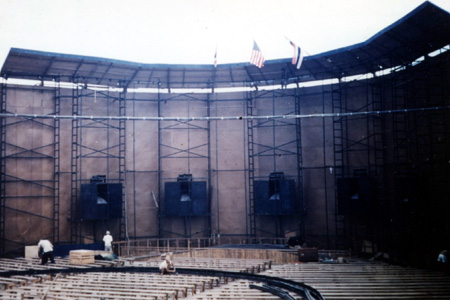 Open
air Cinerama in Damascus. Image Richard C
Babish. Open
air Cinerama in Damascus. Image Richard C
Babish.Oct 12, 1954 This morning at 10am we left Beirut by air for a city called Ammen, which is the nearest airport to the holy city of Jerusalem. While awaiting customs, clearance etc., we had lunch in Ammen and about 2:00 pm started by car for the holy city. The drive was most interesting, along dirt roads that had no guard rails and full of curves and meanderings of hot, arid, and dusty mountains and valleys. At one point, near the Dead Sea we were about 1300 feet below sea level. We passed many scenes reminiscent of Bible stories; girls at water wells filling their earthern jugs and carrying them balanced on their heads, shepherds herding their sheep and goats, adobe type huts and houses dotting the hot barren countryside. At one of the more picturesque wells the director attempted to photograph the activity, but here people do not like to be photographed. During the attempt, the town police arrived and the whole crew just missed being thrown into jail. The director talked himself out of this one. It was unfortunate that the local authorities were not approached first since the scene would have made a good one. After getting out of the difficulties, we continued on the road to Jerusalem. We were traveling directly west, and just as soon as the sun was setting we could see the city on the crest of a small mountain in the distance. I had my camera, but the city was too far away to make a worthwhile shot. By the time we arrived, the sun was too low. However I did get a shot of the moon rising over a hill close to the Mount of Olives. Our hotel is the Orient House, and about ten minutes walk from the old walled city of Jerusalem, and is located in the modern part of town. It was too early for supper, so I took a walk with Fred and entered the city of Jerusalem through the Damascus gate. We entered the immense gate and all around us was the flavor of the east. The smell of spices, people in native dress, the shops selling cloth, shoes, meat, fruit, vegetables, trinkets, etc. We walked down a long flight of stairs to low vaulted avenues where other shops were situated along the Via Doloroso, called the "Street of Pain" where Christ is said to have walked carrying the cross of Calvary. Since it was getting late we returned to the hotel for dinner, had a fair meal and hit the hay. Oct 13, 1954 From a sight-seeing point of view, today has been the most interesting of the trip. The camera is shooting today and as usual no sound. Sound would have been interesting here but they did not want to take the time to unload the plane and get my equipment through customs. Arose early and had breakfast. Took a car hired by the company and drove to Bethlehem, about ten miles from Jerusalem, and visited the Church of the Nativity. A Guide took us into one of the lowest vaults of the church. As I entered the chamber, a small area to the right was pointed out as His birthplace, and about 15 feet on the other side, to the left, the manger where He was laid after bi birth. The whole explanation left much to be desired, and the feeling that the guides story was lacking in many important details persisted. As soon as you leave the church the guide takes you to a souvenier shop where they use every means to get you to buy a lot of trash. We did not falland they were glad to see the last of us. Returned to Jerusalem and had my first daylight view of the walled city. The city is controlled by Arabs and Jews. However, the old city is all in Arab hands. There is barbed wire, armed soldiers, and a "no man's land" dividing the city, and one can only pass with a special permit. We did not do so. I took some 16mm pictures of most of the interesting points, including the Mount of Olives, the Golden Gate (where Christ is said to have entered Jerusalem), St Stephens gate etc. I hope that they turn out well. | |
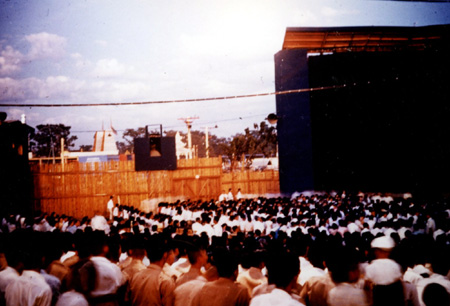 Open
air Cinerama in Damascus. Image Richard C
Babish. Open
air Cinerama in Damascus. Image Richard C
Babish.Within the walled city of Jerusalem there are many interesting sights to see and places to visit. About the center of the city there is situated the Holy Sepulcher, said to be the burial place of Christ, and not very far away, Calvary, the site of his death. Over the burial place, a church has been erected and again Guides give explanations which are difficult to believe. The whole thing is highly commercialized. [During our stay here we were at a hotel called the Orient House.] Although I did not visit the site, nearby is a garden called "Gordon's Garden" This man Gordon is an archeologist, and through forty years research has excavated an area close to his home and uncovered an ancient tomb. This tomb he claims is the tomb which Joseph of Arathamia, a rich man of Jerusalem, offered for the burial of Christ. Nearby is a small hill which he says is Calvary and also close by, the "Place of the Skull", a natural rock formation mentioned in the bible. The actual site of the tomb was discovered by accident. It seems that his supply of water came from a cistern that went dry all of a sudden. He went down with the workmen who were going to repair the cistern, and there found a large vault which subsequently was excavated. To say the very least his story is very interesting and sounds logical based on certain established facts and geographic locations. In any event it makes more sense than the stories repeated by guides. You know how stories grow in the telling. The story that Christ was crucified and buried within the walled city of Jerusalem does not have the ring of truth to me, but that is only my opinion. All the work done here was silent. If the director had any vision, he could have seen the wonderful compliment of sound with picture. With the two you would almost be able to savor the smell of the place, not that it is pleasant, but it is life! At 3:30 in the afternoon we left for the return trip to Ammen, and was that a hair-raising ride! The trip was made in two hours over the road previously described. Since the airport was not illuminated, it was required by the officials that we take off before dark, which was at 6:00 pm. The pilots were running up the aircrafts engines while we were loading the plane, and it is difficult to imagine that all the necessary pre-flight checks were made before we were airborne. However we took off for the return trip to Beirut and rapidly climbed to 12,000 ft to clear the mountains. These rapid ascents and descents are not good for the ears. We have had many of them, and the whole crew is sustaining impaired hearing. The D.C 4 we travel in is not pressurized and when a 12,000 ft climb is made, it gets pretty uncomfortable. The stay in Beirut is short. The crew had permission to land in Beirut to check out the aircraft. It was fortunate that we landed because an oil leak was discovered trailing along the planes fuselage. The leak was not serious but our take-off was delayed about two hours. Plans were to eat on the plane, but we had dinner at the airport restaurant, which was not bad. About 9:00 pm we were given the all clear signal and took off for Istanbul (formerly Constantinople) Turkey. The trip covering about 900 miles was made in five hours and at 2:30 am we were at Pera Palas Hotel after clearing customs etc. Bosch and I had a room together and after a quick wash we went to bed. | |
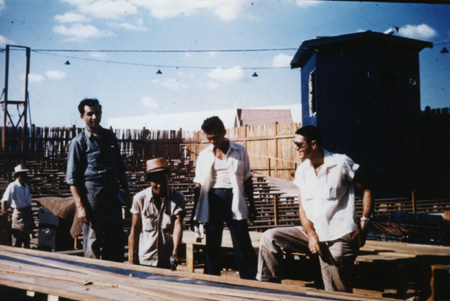 Open
air Cinerama in Damascus. Image Richard C
Babish. Open
air Cinerama in Damascus. Image Richard C
Babish.Oct 14- 15, 1954 At this point it would be wise to point out that our schedule calls for the crew to work in certain cities and areas, the ground work of shooting permits and contacts to be made by two advance men. The details for Istanbul as usual were not taken care of, and as a result two days were spent here doing nothing but standing by waiting for orders. While here we are supposed to shoot the Blue Mosque and the Mosque of San Sophia. While awaiting orders, I took an occasional walk and saw something of the city. There is not much to say for the place. Generally speaking the city is dirty and not very well kept. The people are more or less short and stocky with dress and features somewhat like the Russians I have seen in 1951 on the trip from Salzburg, Austria to Vienna. Turkey is modern in one respect and that is, about 25 years ago, a leader called Mustafa Pasha decreed that 1. The women remove their veils, and 2. That Arabic script be discontinued and English letters of the alphabet be used. There are many ruins from the time of Roman invasions, and at one time the city was completely surrounded by a massive protective wall. Much of this wall is still visible. To me, there were two interesting aspects of the city worth remembering. One was the teeming marine traffic of the Golden Horn or the Bospherus, with its shipping of all kinds. Near the river bank was a little boy in a small boat. He would row from the inner bank to a boat and sell lunch to the sailors, consisting of a piece of fried fish between a loaf of bread, and fruit, which was grapes or bananas etc. In the boat was a small charcoal stove which was used to cook the fish. To me there is a story on this waterfront which would have wonderful appeal. The other sight that impressed me were the Mosques, with the tiny Minerets reaching to the sky, from which the holy men call, in a sort of chant, the faithful, to worship Allah and his prophet Mohammed. These edifices are in most cases very beautiful, with much art and mosaic work devoted to the interiors as well as the exteriors. The food in Istanbul has not been too good, but we did find one or two places where a decent meal could be had for a fancy price. While here, I saw an American movie, "The Merry Widow", which was terrible, a CinemaScope picture. | |
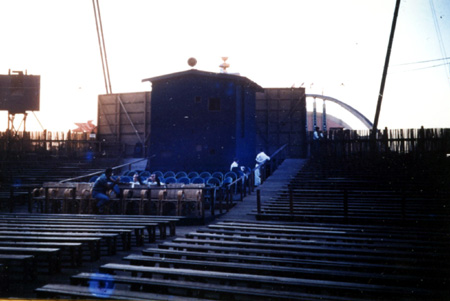 Open
air Cinerama in Damascus. Image Richard C
Babish. Open
air Cinerama in Damascus. Image Richard C
Babish.Oct 16, 1954 We were advised last night to be on tap this am to unload the plane etc. at 8:00 am. Arrived at airport at 8:20 and no one had advised the plane crew that we were unloading so the aircraft crew still not here at 9:30 am. We finally got cleared from the airport at 10:30 am and made four 50 ft shots of scenes in the city, all without sound. Had lunch at 2.30 pm and left for the airport to prepare for the flight to Izmir, in Turkey, where it is contemplated that we will shoot some more ancient ruins. Oct 17, 1954 We arrived in Izmir last night at about 6:00 pm after a flight that lasted one hour. Everyone’s ears hurt from the rapid descent. While in Istanbul, our chief pilot, Dick Connors, was recalled by PAA for another assignment. His place has been taken by a fellow called P. Willie Smith. We will have to speak to him about the ear problems and get him to take it easy in the future. The city of Izmir, a seaport of Turkey, is much more pleasant than Istanbul; at least what I could see after dark. There is a lot of shipping activity. This morning we drove about 200 miles to photograph some more ancient ruins. The last was on top of a hill about 300 metres (1,000) ft high, and Harry did not think it worthwhile. He did not shoot. We returned to the airport hot and tired. Had a flat tire on the way back. Oct 18, 1954 Last night about 6:30 pm we landed in Athens, Greece from Izmir in Turkey. Yesterday # 2 inboard engine developed a leak in the gasoline fuel line which was corrected during the day. The hotel at which we are staying is the King George, one of the first class hotels in Athens. Dinner last night was the best we have had in about two weeks, also the sleeping conditions are good with comfortable beds. The city of Athens is certainly a combination of the ancient and the modern. From the hotel restaurant, one can see the Acropolis with its ruins of the Parthenon and Amphitheatre etc. Adjacent to the hotel are very modern streets and buildings with clean pleasant stores, coffee shops, cafes, movies and theaters. The climate too is different from what we have been used to. Here there is a tinge of fall in the air and the leaves of the trees are turning color – somewhat like home but not as beautiful. The sky is a clear light blue during most of the day, generally clouding up in the afternoon. Spent most of the day looking around the town awaiting customs clearance of the equipment. While here we are scheduled to shoot the Acropolis with buildings etc. and 2,000 Evzones which are the Greek Guards used to protect the King’s palace and grounds. All arrangements have been made to do this by the Unit manager and our advance men. Oct 19-20, 1954 These two days have been spent hanging around our hotel awaiting customs clearance and permits to shoot whatever we are supposed to shoot here. Technically speaking we are on standby orders and cannot leave the hotel for any length of time. Have made a few excursions around the city, but they have not been of much interest. It seems that the 2,000 Evzones previously mentioned have dwindled to 200, but that number would be enough to make an interesting shot if some imagination were used. | |
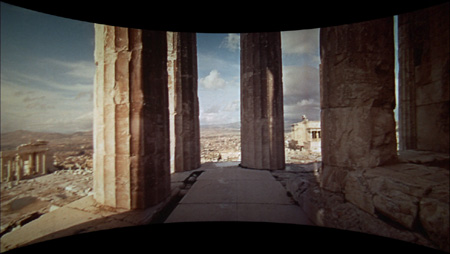 The
Acropolis in CINERAMA. Smileboxed 3-strip Cinerama frame grab supplied
by Dave Strohmaier/Cinerama Inc. The
Acropolis in CINERAMA. Smileboxed 3-strip Cinerama frame grab supplied
by Dave Strohmaier/Cinerama Inc.Oct 21, 1954 We did some productions work today with sound for a change. The shot was in the barracks yard of the Greek King’s Guards called the Evzones. The original 2,000 guards, reduced to 200, and ending up with 60 was rather pathetic to watch. They were supposed to do some formations then do a classical dance to music. The music proved to be a worn out phonograph record played through a distorted amplifier and the guys hardly knew their left foot from the right. All of this was supposed to have been arranged in advance, and we wound up with something like this. It certainly is a shame that the production money is being wasted like this. The director is still in New York and we expect to meet him in a day or two in Paris. Oct 22, 1954 Today is one of the clearest days, that is, less hazy, since our arrival in Athens. This morning we went up to the Acropolis to photograph the Parthenon, and other ancient ruins there; no sound being used which is all right if the shots are static. I took along my camera and got some interesting pictures. Finished shooting about 1:00 pm and returned to the hotel for lunch. After lunch, walked around town, and in the evening, Fred and I went to a movie called “Prince Valiant”. Oct 23, 1954 Today we are scheduled to leave Athens for Paris, however the assistant director wants to do some silent shooting of some more ruins about one hour by air from Athens. The sound crew has not been asked to go along, so we are going to take a company car and tour the city for half a day. We are to meet the balance of the crew at the airport at one o’clock. We took a ride along the seacoast near Athens and enjoyed the scenery, returning to the airport about 1:15 pm. The aircraft did not return until about 3:00 pm, and by the time we got clearance to leave Athens, load the plane, and a permit to land in Paris, it was almost dark when we took off. The run to Paris takes about 8 hours, and is 1400 statute miles. Had supper on the plane, prepared by Pat Hogan and Marty Philben. Most of the crew slept during the trip, but I sat up in the plane cockpit with John Bateman, our co-pilot, most of the trip, and watched the various operations necessary to keep a four engine plane flying at a cruising speed of 180 miles per hour. Also had the aircraft radio head-set on and listened to the numerous massages coming in on the air-line frequency. | |
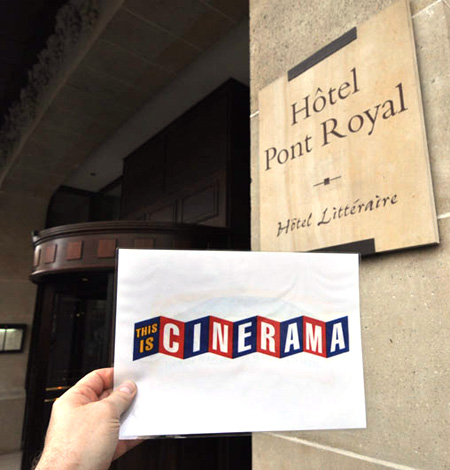 Pont
Royal Hotel in Paris, November 2010. Image by Thomas Hauerslev Pont
Royal Hotel in Paris, November 2010. Image by Thomas HauerslevWithout any incident we arrived in Paris at 1:00 am and proceeded to our old hostelry the Pont Royal Hotel. And so to bed. Oct 24, 1954 These three days have been spent in Paris. Originally we were only going to stay one day with all the arrangements being made by the office that Louis de Rochemont still maintains here. However the day after our arrival, I saw a telegram from the New York office which stated that at the request of W.T., all assistance, guarantees etc., made in Paris for the Seven Wonders crew were to be cancelled. As a result, all of the shooting permits secured were N.G.’d and we had to start from scratch. Of course it has been raining here, but finally we had a clear morning when the Eiffel Tower was shot, the camera ascending the tower elevator, all silent. Since the sound crew was not working, I took a chance to walk around the city and really had a chance to appreciate it after all. The city is very beautiful, and in many parts with spacious streets. Also the buildings and houses are interesting to admire and inspect. The morning of Oct 26 we did some work on the bank of the Seine with Notre Dame in the background, artists painting and talking etc., all without sound! We left Paris for Rome about 4 o’clock in the afternoon, a four hour flight of approximately 600 miles. Nov 1 - 4, 1954 With the exception of Nov 1, 1954 we did not do any production work here in Rome. It took some time to get the equipment out of customs and on Oct 29 we set up the equipment in hired trucks and spent the whole day making necessary gain checks and frequency runs to make certain that we were in good operating condition. In the course of checking, several repairs to the equipment were made. On Nov 1st the feast to commemorate the “Mary Year” was held in the Vatican City, St. Peter’s Square. We recorded and photographed this event in the square, and it consisted of the crowning of Mary, Mother of Jesus, “Queen of the World and of Mankind”. It was a very impressive ceremony. About 10,000 people were in the basilica of St. Peter’s with 300,000 of teeming humanity crowded onto the great square. We also did a scene with the Papal Swiss Guards which did not amount to much. Other than this, we did nothing. | |
|
The first week in Rome the weather was beautiful. The days were warm and pleasant with a tinge of fall in the air. During this time I had a chance to visit around the city. I visited the Colosseum, the old Roman Forum, the Castle of San Angelo, the baths of Caracalla, the Golden House of Nero, and wanted to see the catacombs but have not done so as yet. Rome itself is a very pleasant city with many buildings, churches (about 470) and historical sights of interest. Spotted here and there are many beautiful fountains, which were shown so well in the picture “Three Coins in the Fountain”. The main one featured in the picture called “Trevi” is quite close to the hotel and I have seen it a number of times. It is fed from mountain water brought down from the Alban Hills in an ancient conduit buried under a street called Via Condotti. Rome appears to have an inexhaustible water supply. Every where there are fountains and water taps running day and night all the year round. The shops in Rome are very attractive but I have found that most items, except perhaps food, are very expensive, almost as bad as Paris. The restaurants are very fine. There are large expensive ones for the tourist trade but the best are small places called “Trattoria” which serve excellent quality food and are not expensive. In such a place one may have a meal of soups, spaghetti or fetuccini, meat course wine and fruit and cheese for about 750 to 800 lira (about $1.32). The same meal in a swanky place costs 3,000 lira (about $4.80). Needless to say we have tried all the good places but our old standby is the little trattoria. Most Romans move about the city on scooters (2 wheeled vehicles) which are quite small but very noisy. We have seen the type occasionally out in the country. The women usually ride side-saddle on the back, and I have seen a family of four on one scooter, two adults and two small children. They are very dangerous and to date we have seen four accidents, two involving women pedestrians who were knocked down. Romans are crazy drivers in the city. They zoom up to the cross walks and streets without slowing down and God help the person crossing if he is not watching carefully. The law has restrained the use of horns of all types which makes the city bearable as far as noise is concerned but certainly must help in increasing the accident and death rate of the public. At home we say “rely on your brakes instead of your horn” but here one often wonders what happened to the brakes. | |
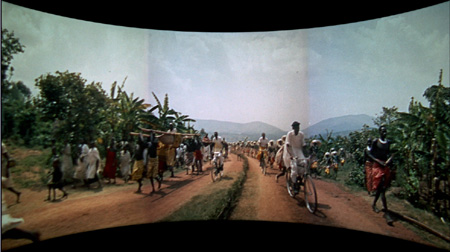 Smileboxed
scene from remastered "Seven Wonders of the World. Image Cinerama Inc.,
2011. Smileboxed
scene from remastered "Seven Wonders of the World. Image Cinerama Inc.,
2011.They say that ancient Rome was built on seven hills. The only one that I have seen is one near the Colosseum. I guess the others have been eradicated or obscured by modern civilization. The fountain of Trevi has a legend which says if you toss a coin therein, you will some day return to Rome. See what Hollywood script writers can do? For the picture "Three Coins" etc. they changed it from the above to some blurb about “a wish coming true” – more romantic perhaps and better box office appeal. Nov 5, 1954 Last night at 8:30 we were told that shooting was finished in Rome and we were leaving for London via Naples. Then at 10:30 the plans were changed. The camera crew were to fly to Naples, photograph silent and then return to Rome. Also that we were to remain in Rome for possibly another week to do some additional scenes. We have been in Rome for eight days. We worked one day, last Monday which covered the Pope crowning the Virgin Mary “Queen of the World and of Mankind”. After attending to some repairs on the Ampex recorder Fred and I took one of the company cars for a tour of the city. We visited the tomb of Victor Emanuel, “Unifier of Italy”, the Ancient Roman Forum, the Colosseum, the baths of Caracalla and the Golden House of Nero. They were all very interesting and I took some motion pictures. Later we learned that the camera crew returning from Naples had not shot a foot of film because there was “nothing there of interest for Cinerama”. This is hard to believe, because the vicinity of Naples is famous for beautiful scenes including the harbor, Mount Vesuvius, and many other sites made famous by painters both professional and amateur. Nov 6-7, 1954 Nothing of much interest has happened. We are still awaiting some decision from someone as to the shooting in Rome and also what our next move is to be. On Saturday night we took in an Italian movie “Ulissie” with several Italian actresses and Kirk Douglas. The picture was full of action but all dialogue was in Italian, dubbed in of course, but I could follow the theme of the story from having read it a number of years ago. It deals with the adventures of Ulysses after the conclusion of the Trojan wars and his return to his native land. Nov 8, 1954 Today we had a 9:30 call for doing some work in Rome. The production work has been cancelled – the sky is overcast and it is raining. Nov 9, 1954 The above is also true for today. The rain is still falling and we do not know how much longer the stay in Rome will last or what our next destination will be. Everyone is getting discouraged from sitting around and it makes it worse not be informed of plans. The sick list has grown, the director has had several attacks and the doctors say that he has a kidney stone. The assistant director is in bed with pleurisy, Squires has had a cold, a bad one since Paris, the other crew members are ailing with one thing or another, mostly colds, and my left ear is bothering me. I feel that the traveling in a non-pressurized plane is causing a lot of our trouble. As a matter of fact the doctor who examined Harry and myself stated that he did not think it wise. However there is nothing much one can do. | |
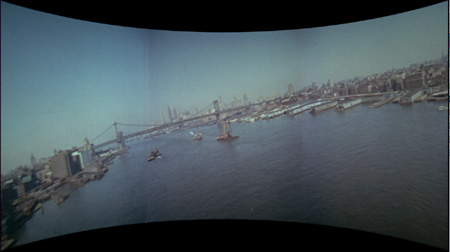 Smileboxed
scene from remastered "Seven Wonders of the World. Image Cinerama Inc.,
2011. Smileboxed
scene from remastered "Seven Wonders of the World. Image Cinerama Inc.,
2011.Nov 10, 1954 Today is the third successive day that it has rained. Earlier this morning there was a patch of blue in the sky, but not enough to “make a Dutchman a pair of pantaloons”, so it clouded over again and has been raining steadily ever since. In spite of the weather, the sun shone brightly in the form of three letters from my wife. They were dated Oct 30, Nov 2, and Nov 3, 1954. All three came from London and had been picked up by the boys of the plane crew who had taken the aircraft to their base in England for a CAA required check-up. My wife is certainly doing well in her writing and her thoughts and opinions on subjects that I have broached are of great and loving value. ....Rome has been enjoyable in the food department. They have pretty much the same food that is available at home. The spaghetti is the finest in the world and cooked “al dente” which means that it is not so soft, but can be bitten with the teeth. At the risk of getting “pastarophobia” I have sampled plus the spaghetti, fettucini, taglionni, gnocchi, etc. Also the wines here are fine, much better than the French. An excellent red wine is called “Valpolidelli” and a sparkling white wine is Listi Spumonti. I am going to try and bring home a case. Nov 11, 1954 The same story as far as weather is concerned. We have had four solid days of rain. Nov 12-13, 1954 At last the weather has cleared up and we are able to do some work again. On Friday am we got the necessary permits to photograph the castle San Angelo within Rome. It is an ancient stronghold across the Tiber River and fairly close to the Vatican City. In ancient days it was used by the Pope etc. as a stronghold against their enemies of which they had quite a few according to history. The director had procured a permit to photograph the front of the castle from a bridge. Subsequently he decided to take a shot from the rear or side. This action was not permitted by the police since the permit specifically stated that the shot was to be made from the front. Everyone was furious but nothing could be done. In the afternoon the location was moved to the site of the old Roman Forum, which of course is now in ruins. It was here that much law was laid down, and of course many historical events took place; i.e. the murder of Julius Caesar, orations by Mark Anthony etc. No sound was recorded today although we should have made sync sound on the bridge scene, but I am not the director. I have tried my best and that is all I can do. Saturday Nov 13 dawned cloudy but by 10am the sun was shining. We left the hotel to look for locations and about 12 o’clock we set up on the inside of the Roman Forum area for a shot. No Sound. Also on the schedule was a scene on the interior of the Colosseum, that ancient Roman amphitheatre which witnessed so many tragic scenes in the pagan days of Rome, before and after Christ. While they were photographing the scene in the Forum, the sound was set up at the Colosseum location, but the camera returned too late from the Forum to do the interior. The sun had gone down below the rim of the building, making the interior too dark. The director said this was a “dry run” and we folded tents for the day. The time is now 6:30 pm, so I am going out for some supper, not having had any lunch. We were too busy getting set up for the dry run. | |
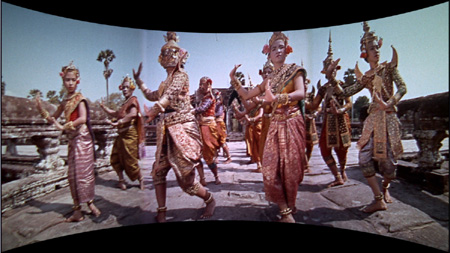 Smileboxed
scene from remastered "Seven Wonders of the World. Image Cinerama Inc.,
2011. Smileboxed
scene from remastered "Seven Wonders of the World. Image Cinerama Inc.,
2011.Nov 14, 1954 Today is Sunday and a beautiful day. This morning we left the hotel at 8:30 am to set up the equipment for a scene in the ancient Colosseum of Rome where in the pagan days of 2,000 years ago, the Romans used it as an arena for staging battles between gladiators, fishermen, contests with lions, and sundry wild animals as well as the execution of Christians to the great delight of the Roman population. It is of immense structure of hand cut blocks of stone and built in the form of a circular enclosure. Much of the structure has fallen to ruin over the period of many centuries, but there has been much reconstruction during recent years. The scene we were making is a view of the interior of the Colosseum with some pilgrims visiting the Holy City of Rome and in their midst, a priest saying a chant for the souls of the Christians who died centuries ago. We had lunch about 2 o’clock, then photographed the monument to Victor Emanuel. Nov 15, 1954 Today is another good day but no shooting has been scheduled. The only news is that Mal Miller is expected back from London. Spent part of the day walking about the city. Nov 16, 1954 Today we were in for a surprise. Marty Philbin has not been feeling too well, ulcers I think, and we got word that he was going back to New York. He has a flight at 3:00 pm on PAA. Everyone is sorry to see him leave. There was no work scheduled today although the weather was good. At 6:00 pm I was reading in my room when I got a phone call from Mal Miller who is staying at the Excelsior Hotel, up the street from the Bernini. He asked me to come up and have a drink. Upon arrival, Mal introduced me to a Bill Lipscomb who came from London with him, and who has been assigned to write the script for future shooting, including the balance of work to be done here in Rome. We had a very pleasant chat, and during the course of the conversation, I suggested that we attempt to do a sequence with Dr. Albert Schweitzer while we were in the Belgian Congo. My wife had sent me a short synopsis of his work and life taken from an article by John Gunther in the Reader’s Digest. Both Mal and Mr Lipscomb thought it a good idea, and wired Bob Heissler who is in the Congo and Lowell Thomas in New York to get their reactions. A sequence of this nature is very timely and should be good. We can record him playing his own organ in the middle of the African jungle. Mal also pointed out that the future operations would be more resolved than heretofore, and that he was acting as a personal representative and as associate producer for L.T. Since Marty has left, I asked Mal if we were going to secure another electrician from New York, knowing well the difficulties involved in getting the passport, visas, and health innoculations. I anticipated what he would say and that was to get along with the crew at hand, in other words, share the load. I was agreeable, but said that I did not want my sound man, Marshall to be relegated to the camera because it would leave my department short-handed. This suggestion was perfectly agreeable to Mal. We chatted until 8pm when I excused myself and went to dinner with Fred. P.S. Today I bought a guitar, or Chitarra in Italian. | |
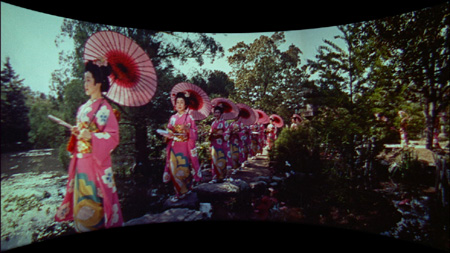 Smileboxed
scene from remastered "Seven Wonders of the World. Image Cinerama Inc.,
2011. Smileboxed
scene from remastered "Seven Wonders of the World. Image Cinerama Inc.,
2011.Our scene was of a family on its way to attend the crowning of Mary, and we recorded and photographed their travel on a motorcycle with a sidecar, travelling a course parallel to the Appian Way, and the subsequent breakdown of the motorbike. With the new writer Bill Lipscomb aboard, it looks like we may get an interesting sequence from Rome after all. We finished shooting and returned to Rome about 6pm. Nov’ 19, 1954 –20,21 These three days were spent in very active location work which included the completion of the Rome sequence. Sat. Nov. 20, we travelled to Castle Gondolfo, outside Rome, the summer residence of the Pope. Mal Miller has been successful in arranging a semi-private audience with the Pope for the benefit of the Cinerama camera. The scene of the blessing of the faithful takes place in an inner courtyard with the Pope appearing on a balcony about 35 feet above the ground. We were given permission to photograph and record a close-up of the Pope, and in order to get the camera close enough it was necessary to build a temporary scaffold for the camera and blimp to be set on. Since the scaffolding was not sufficiently strong to mount the sound microphones and boom, a single microphone pick-up was made, the soundtrack to be subsequently mixed with a wild take that I(?) had made two days previously. We also had several “brute” arcs on the location to lighten the scene which was in the shadow of the courtyard. We made one take and at the request of the Pope we made a second take “to make certain that it is right”, a statement of the Pope. Although I did not have the opportunity to meet the Pope, I was told he was very gracious and received a medal from him, personally blessed as did other members of the crew. (illegible piece of script) Nov 22, 1954. After spending almost a month in Rome, we left today for Napoli which is about 250km (150 mi.) from Rome. For a while the trip, made by automobile, was inland through the mountains, past many Italian villages, most of which had the Communist emblem of hammer and sickle painted on fences and buildings. The country was not very interesting or picturesque. The main feature was the hundreds of vineyards dotted all over the countryside and on the mountain slopes. The people are quite different from Rome, more stocky, squarely built, the typical peasant, especially the women. Most of the agricultural work is done by hand, using very old and, by American standards, primitive tools. The ploughing and harrowing of the soil is generally done by a pair, or four animals which look like oxen or bullocks. They are very large and powerful, and are greyish in color. This part of Italy is a natural watershed. Even so the country has its dry season, at which time water stored in the mountains is sent down into the valleys by means of aquaducts, and distributed to the lands by means of trenches bordering the fields or by means of concrete half conduit used as an open trough. After travelling about 50 miles we came to the coast with its blue Mediterranean Ocean and coastline. On the way down to Naples we passed through many picturesque towns and villages; endless vineyards, orange groves, lemon and persimmon trees. When lunch time arrived, our driver stopped at a typical small Italian village “restorante” where we enjoyed some excellent white wine, pastino in brado, spaghetti as sugo (with sauce), and a green salad. About one and a half hours later we had our first view of Mount Vesuvius, an active volcano close to Naples. Our entrance to the city was I suppose typical of that of most Southern Italian towns; roads swarming with vehicles, horse-drawn carts, trucks, bicycles, and people who were making there way on foot. This trip to Naples is being made to photograph and record local color-dancing, singing, fishermen, etc.. | |
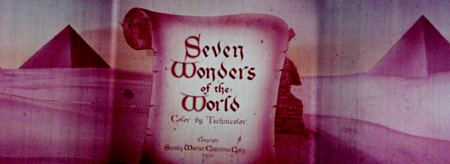 Title
card of "Seven Wonders" in vintage color. Image Cinerama Inc. Title
card of "Seven Wonders" in vintage color. Image Cinerama Inc.Nov. 17, 1954 today dawned clear and cold with the camera scheduled to shoot. Nobody from the Excelsior Hotel, where the “brass” are quartered bothered to notify the sound dep’t if we were shooting or not. When I saw Bob Herndon, the ass’t director, I requested in a very nice manner to please inform me what the schedule was to be in advance, and not depend of a member of the camera dep’t to do or not to do this. He agreed that it was the right thing to do. Since Marty returned to New York, only yesterday, an unpleasant situation has arisen. It seems that the cameraman and brass discussed the situation and decided that my soundman, Marshall, was now to become a member of the camera crew. This all without my knowledge. This was bought to my attention by Herndon and I immediately took exception, and in no uncertain terms said that I would not consent to losing my man, but would cooperate with the crew and have him used as long as I did not require his services. Herndon asked me to explain my feelings on the subject to the director. I put the matter to the director in a very nice way, and he was in accord with my reasons and appreciated my cooperation. I asked him if he needed Marshall this morning since we were not shooting sound and the director said no, but for the sound crew to stand by at the hotel for further order. About ten minutes later Harry Squires stormed in, went up to Marshall who was sitting with me in the hotel lobby, and demanded to know why he was not working with the camera crew. (they have 5 New York men working with them) I told Squires that Marshall was a member of the sound crew, and that he was doing what I had told him to do. Squires made the statement that as of yesterday it had been decided that Marshall was to be with him and that he was not interested in anything I had to say on the subject. I told S that in the future, if he wanted to use one of my men to come to me and ask. He told me to “S--- in my hat”, and that I was not his boss and that he would not ask my permission to do anything. After that S. went over to the director and gripped to him. Apparently the director backed me up, because in a few minutes the camera crew left the hotel with S. And T (?).and left us sitting. Several times during the day S. started to get nasty (we eventually did some shooting with sound) and the director toned him down by telling him not to act so nasty. Prior to this you will note that I had discussed to question with the director and Miller and I am very glad that I did. Little did I realise the importance of these discussions. This is not pleasant to relate, but it is necessary to establish precedent in situations like this. There was a bright spot in that one of our Italian assistants named Tarquini said that he had heard S. ranting and raving. He paid the sound dept the very fine compliment of saying that we were the one group of the entire company who were gentlemen and showed their people some respect. He said that the crew acted too much like the army which was here during the war. The people here have a very bad impression of Americans from tourists and American movies. You cannot go around calling people “wop has----“ , or “wop, Son of a B----“, or “Dago” or a number of other descriptive swear-words, and expect them to do their best. The result is just the opposite and while they accept your money they hate your guts. The shooting schedule called for the camera to work in the morning silent, with the sound crew to stand by at the hotel for a call which eventually came about 1 0’clock, when we received information to proceed to an ancient tomb of a Saint Ceceli (?) on the Via Appia Antica, the old Appian Way, which is a short distance into the country from Rome, and very close to the spot of “Quo Vadis” (Wither goest thou) fame, also where St Peter saw the vision of Christ when Peter attempted to flee Rome and the persecutions of the Christians. You will recall that when Peter saw the vision of Christ, he queried, “Quo Vadis”, and Christ answered, “I return to Rome to be crucified again”. | |
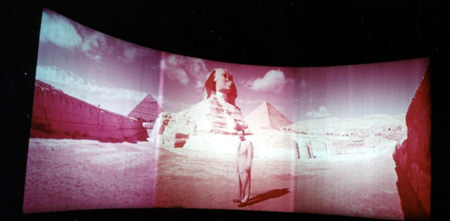 The
pyramids of Egypt and Lowell Thomas. Vintaged colored
scene from "Seven Wonders of the World. Image Cinerama Inc. The
pyramids of Egypt and Lowell Thomas. Vintaged colored
scene from "Seven Wonders of the World. Image Cinerama Inc.Nov 23, 1954 No production work has been scheduled for today. The director and cameraman left a 8:00am to scout locations at Sorrento Amelpi, about 50 mi. from the city of Naples. The crew spent the day investigating the sights of the city which is quite dirty compared to Rome. Although, as it will turn out, we are only to spend one day, the thing that I will remember about the cosmopolitan life is the great amount of family wash hung about; from windows, on trees in the streets, and every imaginable place, in full view of all who pass. The director etc., returned to the hotel at about 6:30pm, and upon arrival found a cablegram awaiting them from Bill Meissler (?) who is in the Belgian Congo, Stanleyville. The cable stated that if we were to photograph and record the Watutsuie tribe near there, if would be necessary to arrive there on Friday Nov 27 at the latest. A decision was made to drop all work in Naples and leave for Rome at 5:00am tomorrow morning to prepare for a take-off for Africa. Nov 24,1954. As scheduled, we left for Rome at 5:00am without breakfast. I was certain that half an hour taken for breakfast would not have made any difference, and would have started the day right, which later proved to be the case. The crew has missed many meals on this trip, working all day and having lunch at 4 or 5 in the afternoon. This is always the decision of the director, and the job of the unit manager, siteman(?) is to see that we are all fed on location, but not once has he supplied the crew with food. The trip by car to Rome was made at a fast clip and we arrived at 9:30am. As I suspected we spent the balance of the day clearing customs, securing plane clearance to Beirut and Stanleyville etc. The plane crew, which was in Rome, did not have an inkling of the change of plans until 11:30 am today. | |
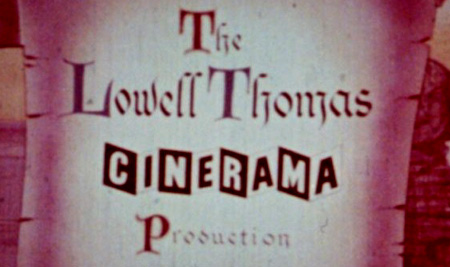 Title
card of "Seven Wonders, vintaged colored
scene from "Seven Wonders of the World. Image Cinerama Inc. Title
card of "Seven Wonders, vintaged colored
scene from "Seven Wonders of the World. Image Cinerama Inc.At about 9:00pm we took off with two additional passengers, their baggage and a load of gas(?) to carry us over 1200 miles to Beirut where we are to refuel. The takeoff from Rome was not good, and I found out later that we were 3,000 lbs over-weight. The plane had a tough time becoming airborne because of the additional weight, and we were almost at the end of the run-way before we finally got into the air. The new passengers are an Italian accountant and a female interpreter who speaks French, English, Italian, and Arabic. The accountant was hired to take care of entering and accounting for the money spent, which must be prodigious. No other person (there are five) could take care of this business. The girl, an Egyptian by birth, Miss Eileen McCullen, was sent from New York to act as a linguist and go-between primarily for our shooting in Saudi-Arabia, if we ever get visas to enter that country. Although these people are nice, they just add to the complications of the trip and make it that more difficult. In order to lighten the planeload in Beirut we had to remove about 1100 lbs. of camera and sound equipment (my Ampex) so that we could put sufficient fuel aboard to reach our destination in Stanleyville, Belgian Congo. Nov 25, 1954. Today is Thanksgiving Day and we are celebrating the day in the city of Beirut in Lebanon, on our third trip to this area. We arrived at the airport at 5:20am from Rome after a 9 ½. hour trip covering 1900 mi. non-stop. Everyone was tired after the long flight so we went to a hotel to rest and clean up. In a few hours we got up and several of the fellows including myself went into the city to renew acquaintance with the sights, and visit the gold bazaar. At 7:30pm we left the hotel for the Beirut airport where we were to take off at 9:00pm for Stanleyville. The take-off in Beirut was much better than Rome because of the lighter load. We now have two additional passengers plus their baggage, which has added considerable weight. We left about 10:pm and flew non-stop to Stanleyville in 11 ½ hrs, arriving there at about 9:30 am Nov 26, my birthday, which I had almost forgotten. Nov 26, 1954. Upon arrival in Stanleyville we were met by Bob Heissler who explained in detail to the “brass” which is of course exclusive of Squires and myself, the plan to be followed in working with the Watutssie tribe. It was necessary to fly to Usumbura, about 370 mi. from Stanleyville, which we did, leaving Stanleyville at about 3:00pm. This flight was made during the day and was quite interesting as we flew most of the distance through a range of mountains, following a fairly wide but long valley. About ten minutes before landing we saw a very large lake, which was Lake Tanganyka, about 3 degrees north of the equator and very close to the geographical centre of the continent of Africa. We landed at a very nice airport with a rather short dirt runway, and the pilots really had to break the ship to prevent over shooting the field. | |
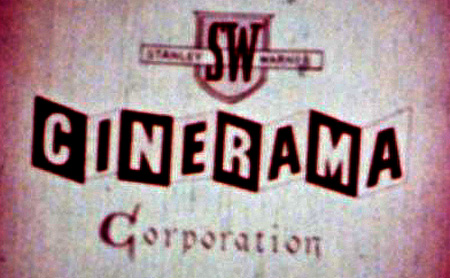 Vintaged
colored title card from "Seven Wonders of the World. Image Cinerama Inc. Vintaged
colored title card from "Seven Wonders of the World. Image Cinerama Inc.The town of our destination is called Usumbura and it was quite a surprise considering that in 1929 this country was all jungle. There were two hotels in the town called the Grand Hotel and the Paguidas Hotel, both run by Greeks, whom I have mentioned before as being very enterprising in the African jungle. Although the town is small, there are paved streets, modern stores for Europeans, most of which are Belgians. There are also stores where the natives can purchase their supplies. (I am writing this en route by air to Stanleyville and it is bumpy). After clearing customs and unloading the plane of equipment, which was put on two trucks (I have constantly asked for three) we rode into town and put up at the Grand Hotel. The tropical darkness had settled early so I did not have a chance to see Usumbura. Had a good dinner at about 8:30 pm and went to bed early as we are leaving by car and truck for Astrida and Nyanze (home of the Watutssies) at 5:00 am tomorrow morning. Nov 27, 1954. Today will prove I think, a turning point in the trip. After travelling 3700 miles in two reckless days and spending over 20.000 dollars for plane costs alone, it has been decided to cancel the shooting here. The story follows: This morning at 4:am we arose and had breakfast with the idea of leaving at 5:am by car and truck on a trek from Usumura to a town called Astrida and from there to the African village of Nyanza. We had four automobiles for the crew and three trucks for the equipment, rental for same about $600. for three days. After a delay of 11/2 hours. Looking for the truck drivers, Africans, we left the hotel. It was raining, this being the start of the rainy season in the Belgian Congo. The road mileage from Usumbura to Astida is 170 km, with a constant climb up the mountains from an altitude of about 2000 ft to over 6.500 ft. The road that we travelled was dirt and stone, but in very good condition having been constructed originally by the Germans when this part of Africa was a German colony. The Germans lost it after World War 1, when it was given to the Belgians. Very good planning was used. The road skirts the side of the mountain and at almost every point along the way there are sheer drops, in some cases of better than 1500 ft. To prevent accidents, the whole distance is fringed by pine trees set 6 to 8 feet apart. Besides serving as a barrier it is very decorative. The county is densely populated by Africans and almost every inch of ground is under cultivation. | |
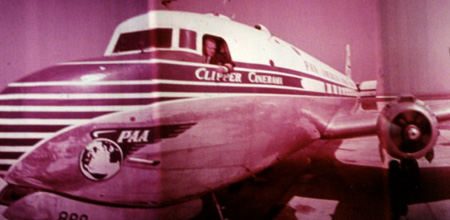 "Clipper
Cinerama", the airplane used in "Seven Wonders". Vintaged colored
scene from "Seven Wonders of the World. Image Cinerama Inc. "Clipper
Cinerama", the airplane used in "Seven Wonders". Vintaged colored
scene from "Seven Wonders of the World. Image Cinerama Inc.There is corn, coffee, vegetables of various kinds, fruit and thousands of banana trees. The homes are of a kind of mud adobe with thatched roofs. Most of the homes have a single fireplace inside for use at this time of the year, but the only way that the smoke can get out is to find its way through the thatched, straw roof. It certainly is a funny sight to see smoke coming from all quarters of the roof, giving the effect that they are on fire. The natives are quite civilised, and more of less fully clothed, with pieces of bright colored cloth or cotton blankets. The country is much less mild than that which we visited in Aba (?) and Juba in the Belgian Congo where we photographed and recorded the elephant school. Again, as on that trip, not a sign of wild life was to be seen, and the natives carry only sticks for protection. I did not see one native carrying a spear. The destination of Astrida was reached at 11: am. The town of Astrida is quite modern, and nothing unusual was to be seen. We strolled around town for about one hour and returned to the Hotel Foucon for lunch, which was only fair. While eating lunch the head men contacted the King of the Watutssie tribe quite by accident, at another hotel in the town, and at about one o’ clock returned to the hotel Foucon with the astounding news that we were unable to make the sequence because he, the King, would be unable to get his tribe together for two weeks. How ridiculous can an operation get! We have travelled 3700 miles under very trying conditions, flying through valleys with 6 and 6000 foot mountains on either side. Through fog and rain and a perilous automobile trip to learn that tomorrow we are to return to Stanleyville by air and return to Beirut, thence back to Rome. We have moved so fast I have not even had an opportunity to take any motion pictures of this part of Africa. At 2:30pm, after a severe tropical wind and rain storm, we left by car from Astrida for the return trip to Usumbura, which was made without incident. On Sunday, last, upon arriving in Stanleyville, I had a cablegram handed to me by Bob Heissler. The message was from Ramona, Rich and Roger wishing me a happy birthday (which I had almost forgotten) and say that they had a fine Thanksgiving and were all well with a letter to follow. I was glad to hear from home and know that all was well. Nov 26, 1954. This morning at about 12 noon under very adverse weather conditions. There was plenty of rain and low hanging fog, and our take-off strip was thoroughly soaked and muddy. Our distance in miles to “Stanleyville” is about 400, most of which is to be flown along a valley with 6000 foot mountains on each side. – a fairly easy trip in good weather; but in the fog -! I spoke to our captain, Page W. Smith and he said that under normal regulations he would not take off under the conditions, but since we are in the tropics, he was not afraid of a wind drifting us off the course. He is an excellent pilot, and knows what he is talking about. Aside from quite a bit of rough weather, we landed in Stanleyville at about 2:00 pm. We are to stay here overnight and leave early tomorrow, Monday, for Beirut. I did not see any of the town since the airport is about 5 miles away, and we are staying in the ‘Sabina’ Belgian airline rest house, which is also 5 miles outside of Stanleyville. En route here I had a short but good look at the Congo River. Right now we are about in the center of the African continent... Nov 29- 30 1954. Left at 8:30 am for Beirut, Lebanon, and after 13 ½ hours of non-stop flight, arrived at 10:00 pm. Got to the hotel and went to bed – dog tired. On Tuesday 30th we were up at 6:00 am and left at 8:20 for Rome. The flight lasted 7 ½ hours and was very good. Weather clear with beautiful aerial views of the isle of Cyprus, Rhodes, Capri and Mount Vesuvius. The captain flew the ship right over the crater and I took some movies- hope they turn out well. Got to the hotel at 5:00 pm, too tired to sleep. Will write home before going to bed. | |
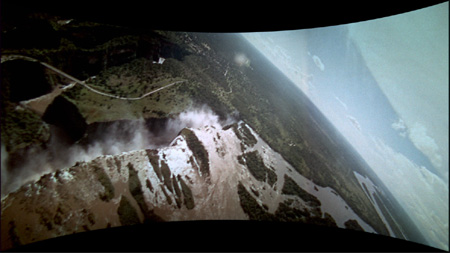 Smileboxed
scene from remastered "Seven Wonders of the World. Image Cinerama Inc.,
2011. Smileboxed
scene from remastered "Seven Wonders of the World. Image Cinerama Inc.,
2011.Dec. 1, 1954. After returning from the Belgian Congo, four days were spent in Rome again awaiting clearance of the equipment from customs with the crew primarily standing by at the hotel awaiting orders. A decision has been made to shoot the interior of St Peter’s to tie in with the sequence made in Rome before leaving for the Belgian Congo. This presents quite a lighting problem and it will be necessary to secure as many lights as possible to be placed as inconspicuously as possible since the work is to be done during the enactment of an actual church ceremony. During this filming of this sequence, sound was recorded although not in sync with the picture. This is known as wild track and can be nicely (?) fitted to the picture when it is edited. Wild sound can be made under conditions where there is no dialogue or other action close up to the camera. Since Mal Miller has arrived on the scene the moral of the crew and the objectives of our work has been considerably improved. He knows how to handle men, is direct and firm when the occasion arises and has a good approach to our problems. I have had several conversations with him. Among the items discussed were: 1. Frequent production and planning meetings. 2. Schooling of directors at home relative to limitations and potentialities of the Cinerama Process. 3. The possibility of doing a sequence with Albert Sweitzer. 4. I offered my services in any way that would be of assistance to him. His wife Joan is with him for a short time and is a very nice person. On Tuesday last, Ted Tetzlaff went home a very sick man. An attempt was made to remove a kidney stone without success by mean of a non-operative method. Accompanying him was the ass. Director Bob Herndon who left to get married. Dec. 8, 1954. Today has been spent in preparation for leaving Rome for Athens where we are to re-do the Greek sequence. The plane left the ground at 4:30 pm. We were advised by Page Smith, the captain, to expect some rough weather in the form of three storms. The ship flew at an altitude of 12.000 feet to get over the weather and we managed to miss 2 of the 3 storms. We did run into some rough weather coming into Athens. Arrived about 8:30 PM covering about 700 miles. Dec. 9, 1954. Nothing is scheduled for today awaiting customs clearance of the equipment. Browsed around the city which I have described before and at 6 PM Mal called a production meeting to discuss the Athens schedule – a big difference in the organisational policy. In the evening saw the picture “Limelight” with Charlie Chaplin and Clair Bloom. She is very nice. Dec. 10, 1954. Last night at 11:30 PM a new director arrived in Athens to take over the job of continuing our production “Seven Wonders” He came direct from Hollywood via New York, London and Rome. This morning I had the opportunity of meeting and speaking with him. He impresses me as being a very personable type of man and has a good deal of experience in motion pictures being associated with the production of “King Solomon’s Mines” and other pictures of an outdoor nature. His name is Rene Marton, born in Hungary and raised in the Austrian Tyrol. During the morning Mal called a meeting of all crew personnel and he was introduced to the entire company, a very commendable procedure. He gave us some information from home, L.T. and Gen’ L. Coop to the effect that the shooting done in Rome is the best to date and that they are pleased with it. After the meeting concluded, Fred, John Batemen (our co-pilot who is working on the side for the company) and I went over the entire recording channels to make sure that it will be in first class condition for the shooting contemplated in Athens. After finishing at 6:00 PM I stopped at the American Express and picked up my wife’s letters which contained everything I hoped she would say. She is a fine girl and mother. | |
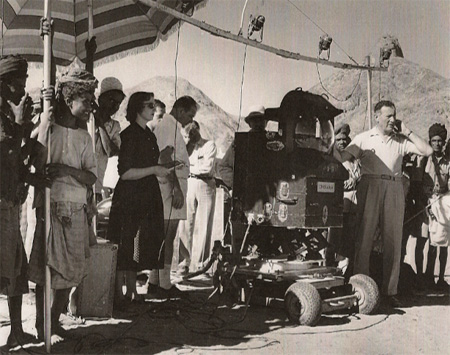 Scene
from filming of "Seven Wonders of the World. Image David Strohmaier. Scene
from filming of "Seven Wonders of the World. Image David Strohmaier.Dec. 11, 1954. Today has been spent in making preparations for filming at the Parthenon. We are going to shoot sync sound there. The Acropolis upon which the Parthenon is built is about 500 feet high. Completely surrounding the summit is an embankment of stone and concrete which at some points drops down 100 feet or more. The hill then tapers to ground level gradually but the terrain is very rough and rugged. From the description it can be seen that it is very difficult to manoeuvre equipment to the top, especially the heavy generator etc. At the west end of the Acropolis there is an engine driven cable lift and I have been negotiating with the engineer in charge for the use of the lift which would simplify the job. He wants $350 for use of the hoist which is much too much money. I had thought $100 would be sufficient, but we are still talking terms. This evening we had a nice dinner consisting of onion soup, roast pork and mashed potatoes, a pickled beet and tomato salad, red Greek wine and a desert of tangerine ice cream served in the shell of an excavated tangerine with its top. Quite a novel touch. Another bit of news, Mike Mahoney, the camera grip, a very nice fellow, received $100 increase in salary bringing his pay to $325 per week, a nice increase. Perhaps I should try again for the figure of $450 I requested but did not get from Walter Thompson when leaving New York. Dec. 12, 1954. Today is Sunday and the sky is overcast and full of rain. There is not much to do except stay around the hotel and relax and read. At its best hotel life is a lonely one. Had a lunch at the airport and supper in a restaurant close to the hotel. Dec. 13, 1954. The weather this morning was quite cold and very windy and cloudy. About 11:00 AM and the new director decided to go to work filming some silent shots on the Acropolis. The wind was blowing a gale up there and sometimes it was difficult to keep a footing and hoping that one would not be blown off. Several static shots were made and three were made with 4 men of the Kings guard called Evzones.(?) The cost to hoist the equipment is too much as indicated in last Saturday’s log and I have decided to park the generator at a point on the North side of the Acropolis which will require a minimum run of power cable. We will have to buy an additional 100 meters (1 meter = 3ft) to do this job. The director and I have discussed the sound requirements of the filming to be done in the Parthenon on the Acropolis and the temple of Zeus or Jupiter which is located in the centre of the city where there is a lot of traffic noise and not good for direct or in sync with camera recording. I am going to prerecord the music for both sequences and use the pre-recording as playback in sync with the camera when the photographing is being done. Had an early dinner consisting of onion soup, lobster au gratin, beetroot salad and a good Greek wine. For desert I had chocolate ice cream. After dinner Fred and I saw the CinemaScope Fox picture “The River of No Return” with Marilyn Monroe and Robert Mitchum. The picture was fair but Monroe can hardly be called an actress. Most of the shots consisted of close up “drooping bosom” angles. On second thought, is that bad? Dec. 14, 1954. The rain came down heavily last night and the dawn was grey and cold. Filming has been scheduled but due to the lack of good light most of it was cancelled. Had a light lunch in town and the street where the restaurant is located became the scene of a riot put on by male students of the University of Athens. At present the island of Cyprus is a military stronghold under British protectorate. The Greeks have requested that the island with its 85% Greek population be returned to them. The question was put up to the United Nations. The United States voted with Great Britain against the return of the island to Greek control and this was the cause of the riot; anti-British and anti- American. Dec. 15, 1954. Today the camera shot silent and I spent most of the day locating two sites to do some musical pre-recording to be used as a playback for filming and some Greek folk dances in the Temple of Zeus and classical Greek dancing at the Parthenon. | |
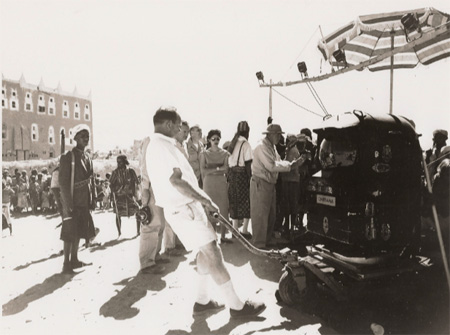 Scene
from filming of "Seven Wonders of the World. Image David Strohmaier. Scene
from filming of "Seven Wonders of the World. Image David Strohmaier.The music for the Greek dances was to be made out-doors and it was quite difficult to select an area that was free of traffic noises but I found one in the hills about ½ hours drive from the centre of the city. The classical dancing is to be done with an orchestra of 20 musicians and I found a good room for the indoor recording at the Columbia Gramophone Studios in Athens. Tomorrow is the date set for both recordings and I hope that the weather will be good for the outdoor session. We are leaving the hotel at 7:00 AM to be ready for the musicians who will arrive at 9:00 AM.. Dec. 16, 1954. Left the hotel this morning as scheduled and found upon arrival at the garage that extra men to do the heavy work and the truck driving had not been advised to be there at 7:30 AM. Consequently we lost an hour and arrived at the outdoor location with the wind howling and military aircraft roaring overhead. Today was the first clear day in a long time so full advantage was being taken of the good weather by the Greek airforce. Between the two hazards I managed to get some good outdoor music for the folk-dancing sequence. The orchestra consisted of 5 men; a violin, a clarinet, a lute, a zimbaline ( a stringed instrument held in the lap and struck with a padded mallet in each hand) and a tom-tom like instrument like a drum. The music was interesting although a bit long and monotonous. In the afternoon I went to the Columbia studio and recorded a 20 piece orchestra under the direction of one Menelaos Palladios, who also did the musical arrangement. He liked our recording of the music and I too, thought it was good. Returned to the hotel about 8:30 PM and had supper and went to bed. Dec. 17, 1954. This morning dawned beautifully and all arrangements have been completed to do the camerawork with musical playback (recorded last night) . The weather was just right for filming. We had everything set up by 10:00AM when the ballet mistress arrived with the girls. After a half hour practise the ballet director said that it was too cold to work then but perhaps she would return at 2:PM. Apparently there was nothing the director could do, so we all sat down and waited. At 2 she did return but by that time the sun was covered by low-hanging clouds with only an occasional patch of blue to be seen. The result as you may guess was a complete loss of the day. About 3:30 just before the girls were sent home the sun did manage to break through but director and camera thought that the shadows were too long and decided not to do the shot. If it should rain tomorrow we will be out of luck altogether since we expect to leave for Cairo on Sunday. Dec. 18, 1954. Guess what ! It is raining and cold as the devil today. Not a chance in the world for us to work today. Spent the day relaxing at the hotel. The unit manager Art Siteman, has been in Cairo and returned this AM bringing a batch of mail. I had several letters and Christmas greeting and a letter from Mona. It was good to hear from my wife and friends at home. If the weather is clear tomorrow, Sunday, we will attempt to finish some of the work left uncompleted. In any event I am told we are leaving for Cairo tomorrow afternoon. Dec. 19, 1954. Today is Sunday and it is raining again with no possibility of finishing the Greek sequence here in Athens. We are scheduled for a 1:00 PM takeoff but because of personnel payment problems, customs and clearance difficulties we were unable to take off until 3:30 PM. Our route calls for a flight from Athens passing over the Dadecanese Islands to Beirut where we are going to land for some supplies awaiting the company and Christmas mail and packages. The flight to Beirut took four hours and we covered a distance of 750 miles and was made without incident landing in Beirut at 7:30PM. Upon arrival I was given 6 letters and or Christmas cards including the Christmas package from my wife and greeting from the boys. I have specific instructions not to open the package until Christmas and on that day will do so, probably in Saudi Arabia. About two hours after landing we took to the air again travelling to Cairo in two hours and forty minutes, about 450 miles. The plane was unloaded of baggage and equipment since we are going to film a short sequence with Lowell Thomas when we expect to meet him here. | |
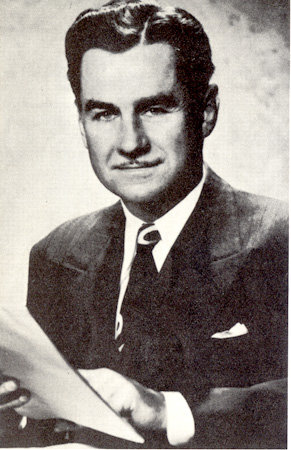 Lowell
Thomas Lowell
ThomasDec. 20, 1954. L.T. arrived last night from New York via London about 3:00 AM. We had an eight o’ clock call and we are going out to the Pyramids to do the sequence. The “Star” arrived on location about 9:30 AM with a hearty greeting to the crew. Mrs. Thomas was with him and she was glad to see everyone. Accompanying them was a fellow named Bill Terry who is going to replace Art Siteman as business manager, and a girl photographer from Life magazine. During the day several shots or scenes were made with L.T. We expected to finish in Cairo in one day but the day is not long enough so we will continue tomorrow. The Christmas cake that I have been looking for has not arrived at the Semiramus Hotel and I am afraid that I will not get it. In the evening Mrs Thomas gave a cocktail party for the crew and delivered mail and Christmas packages from home to the fellows. I received mine from Mona and the boys and enjoyed the contents. Had dinner at the St James Restaurant in Cairo and went to bed about 12 midnight. Dec. 21, 1954. Today dawned very hazy and it as not until 11:30 AM that the director decided to Shoot. It was his decision to make two silent shots, one of Lowell at the Pyramids and one of the boats called “Feluccas” which ply the Nile River from Cairo to Luxor, about 600 miles east of this city. The boats are very colourful from a distance, having the peculiar triangular sail for which they are famous. I believe that the sailing rig is called “lateen” but will have to check this information. The plan for the day calls for shooting until 2:00 PM and then meeting at the hotel and then leaving for the airport to prepare for the flight to Aden. This afternoon Jack Priestly (asst. Cameraman) is leaving for New York for a medical operation. It seems that he has a cyst at the base of his spine which ha to be removed by surgery and also an anular fissure which also requires attention. The operation is to be done at home and he is to return in three weeks. As always on this trip, bad planning and arrangements did not permit us to take off for Aden until 8:30 PM; about five hours behind schedule. The reason is quite obvious in that decisions to do too much always result in too little too late. The flight to Aden took about 9 hours covering a distance of 1700 miles and was very dull with the exception of my sitting up front with the co pilot, John Bateman, and chatting with him for about two hours and watching the various stars and constellations which were very clear and beautiful. We had a good dinner prepared by Pat Hogan, our steward, and arrived in Aden just at the break of dawn. The morning air was cool and invigorating and quite a change from our last visit in October when it was hot and muggy. Dec. 22, 1954. From the town we proceeded to a town called Steamer Point in Aden and put up at a good hotel called the Crescent, where comfortable rooms were to be had. A decision was made to prepare equipment and personnel for the immediate flight on two DC 3 planes of Aden Airways which will take us into the interior of the West Aden Protectorate (British) to a small Arabian town called Baihan. By 2:00 PM the first plane and part of the crew with equipment took off to be followed by a second aircraft containing the balance of the crew. I was scheduled for the second flight which was delayed because of one rough engine. By the time the engine was adjusted it was too late to take off so the flight was cancelled until 5:30 AM tomorrow morning. In the evening the people remaining in Aden, including Mr. And Mrs. L.T. were invited to attend a cocktail party at the American Consul, whose name is Eugene Delgado. As soon as I was introduced to him I knew that I had seen him before and told him so. He said that he had the same feeling, but a comparison of countries and places visited did not coincide. I could not get this recollection out of my mind and finally asked him if he had gone to school at Brooklyn Tech. That was the answer and we ended up almost kissing each other on the cheek, French style. A pleasant evening was had by all and we retired to the hotel. Mrs. Thomas asked Fred and me to ride with here and L.T. and I sat next to her at dinner All in all a pleasant evening. We all went to bed early since we are getting up tomorrow morning at 3:30 AM. Dec. 23, 1954. Today will prove to be the hardest working day that we have had to date but the most interesting and spectacular and colourful in scenery and people with their living habits and customs. This morning we took off in a chartered DC3 plane for the flight from Aden to Baihan at 5:30 AM just as the sun was coming up through a low bank of heavy clouds far on the horizon. Although the trip only takes one hour, our pilots, two very nice Englishmen, have told us that they will fly over several spectacular so we can have a good look from the air. One of these is an ancient Arabian city built on a small plateau of a mountain about 4,000 ft high, and another is an ancient dam built to store water during the rainy season which starts in June. This part of Arabia consists of a desert of very fine brown colored sand and ranges of volcanic mountains rising in some places to 7.000 ft above sea level. The mountains are absolutely barren without the trace of a tree growing in anyplace except the valleys. Geographically they are probably younger than our mountains in the eastern part of the United States because they contain many hundreds of gagged and rug peaks climbing high towards the heavens with great visible furrows caused by erosion from rain and wind. During the rainy season the torrents of water pour down these slopes with terrible fury to the villages below with the speed of an express train causing great wrinkles and furrows to appear on the face of Mother Earth. | |
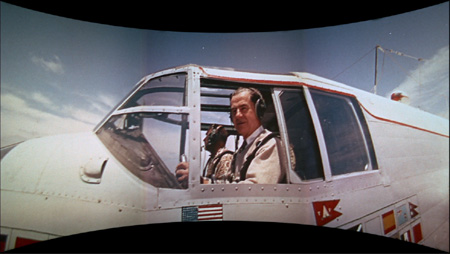 Lowell
Thomas in the airplane. Smileboxed 3-strip Cinerama frame grab supplied
by Dave Strohmaier/Cinerama Inc. Lowell
Thomas in the airplane. Smileboxed 3-strip Cinerama frame grab supplied
by Dave Strohmaier/Cinerama Inc.After flying about one hour we came to the town built on the mountain plateau and it was a very interesting sight from the air. I took some 16mm pictures from the pilots cockpit but had to give up my seat to L.T. who wanted to see the sights from a better vantage point to incorporate his views and reactions on tape for a broadcast back home. Later on we passed over the large dam which did not look like much from the air and still later flew and circled quite low over an area reputed to be the stronghold of the Queen of Sheba 1,000 BC or about 3,000 years ago. We flew low over the area and saw some excavating work on a temple which appeared to be buried deep in the sands of the desert. After this we changed our course toward Baihan and flew over a section of the desert covered with immense sand dunes, some 30 or 40 ft. high which stretch out in inter-mittant parallel lines for as far as the eye can see. These dunes are caused by the monsoon winds which sweep for a season of each year over this vast void of arid, barren hot country. After about 1 1/2 hours of air sight-seeing the aircraft put down on a sand airstrip located in the valley of these mountains and about two miles from the town of Baihan. As soon as we landed, several Arabian tribesmen came up to greet us mounted on horses with a salute fired from their rifles and they appeared very glad to welcome. We were introduced to the leader of this village, Sherif Hussein and several of his cousins and relatives and a hearty handshake was given all around. Then after posing for pictures, we took off in the Sherif's car for the town. Since Squire and the Camera crew had arrived the night before, they were all set up on the location and it was necessary to organize the sound and electrical departments. The difficulty that I have been working under due to the loss of my French soundman, my assistant sound man Marshall and Marty Philbin, electrician, have been prodidigous and today's operation proved beyond the shadow of a doubt that replacement men are needed at once. Fred and I have been doing triple duty since these men have left with NO help from the camera crew or grips. We did have a number of natives to do the heavy lifting etc. and they were very willing and accomplished a lot in spite of the language barrier. However too much happened during the day to dwell on the difficulties. When the day's work was finished we both were very tired. | |
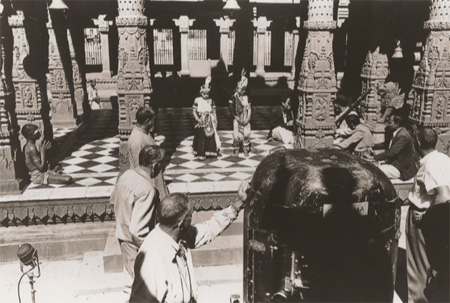 Scene
from filming of "Seven Wonders of the World. Image David Strohmaier. Scene
from filming of "Seven Wonders of the World. Image David Strohmaier.The locations shots were normal setups for this part of the world; camels, native Arabs all men, tents and plenty of noise and gunshots. What interested me was the town itself and the people. The town itself consisted of about 75 or 100 houses and structures of various sizes, ranging from a small hut to a large two-family house which the crew lived in over-night. All of the structures were made of adobe-type mud mixed with straw to hold the mixture together. The house we stayed in had four stories, each about 15 ft. high and the frame was a kind of trap rock with the outer surface covered with this straw-reinforced mud. The architecture was more or less of a square nature with some curving and decoration given to the windows on the interior. We slept in a room that had eight cots set up in it. The room had several tiny windows that were glassed in with red and blue tinted glass. When the sun streamed through these panes of glass a multi-color effect was given to the interior of the room which was very pleasant. The sanitary facilities, if you can call them that, of this part of the world are very unique. In each room there is a urinal made of adobe which is completely open with two pedestals about four inches above the floor where the males stand or the females squat, as the case may be. Of course the sexes are separated so there is not much need for privacy and one does not get any. The flow from the urinals goes to a long trough which leads to the outside of the house and drips to the ground. One has to be careful not to walk too close to the houses or he may be surprized by an unexpected shower bath not consisting of fresh clean water. The toilets are also unusual in that essentially they are the same as the urinal in construction, no place to set, and one placed above the other. They are just open holes starting from the top floor of the house and constructed so that the hole in a room, say in the middle storey of a three storey building is placed in line with the hole above and the hole below. It is just too bad if a fellow is squatting in the middle room and another fellow has the same idea on the floor above. At present in Baihan there are many Arabians of different tribes gathering for the purpose of making this sequence of the film and there are a couple of hundred camels. Almost all are men. The few women to be seen are veiled heavily. Most of the men carry rifles which are fully loaded and ready for action. All of the men carry a curved knife called "Jambia" carried in colorful sheaths made of hand-wrought silver and gold. The Jambia is most interesting and I am going to buy one if I can. Since Arabians are of the Caucasian race, most have very fine features. However there has been some inbreeding with the African negro who at one time were the slaves of the Arabs. The men of the Yemen, a district of this part of the Arabian Peninsular, wear their hair cut to the nape of the neck and usually with a black or colored headband somewhat similar to the American Apache Indian. They are a warlike tribe and can be treacherous if aroused. It is difficult to say much about the women since I have seen very few and they are all heavily veiled and clothed so that you cannot see their features. The children however, are most interesting, both boys and girls. Native children for the most part are fine featured with large black eyes and olive colored skin. Some of the boys of certain tribes have all their hair shaved except for a tuft about six inches long left on the top. I understand that this tuft is used as a handle for Allah to use if the boy falls into evil ways, and permits Allah a means of plucking the boy a way from the devil. The girls are more or less dresses gaily and sometimes the family wealth is strung around their necks, arms, ears and legs in the form of silver trinkets. Most of the girls have their ears pierced four holes in each ear from which are suspended silver trinkets and coins. Some of the girls faces were painted yellow which I believe is saffron and this coloring gives them a rather eerie appearance. They had a head of hair which was braided with, I should judge, about 100 tiny braids on each head. In and around the town there were many shops of various kinds- shops dealing in spices, meat which is slain on the spot, matches, tinned goods, soap, chewing gum, cloth, wheat and other grains, silver-smiths, gun-smiths, tin and brass workers, beaters of the indigo seed into cloth for use as turbans and head wraps, oil manufacture- all very primitive. The one modern feature in the town besides a couple of automobiles and one truck was a gasoline powered grist mill where the natives brought their grain to be ground into flour. | |
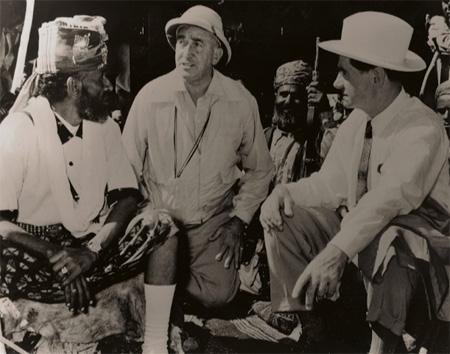 Scene
from filming of "Seven Wonders of the World. Image David Strohmaier. Scene
from filming of "Seven Wonders of the World. Image David Strohmaier.Of course water in this country is a great problem and is drawn by camel power and by hand from the two or three wells dug in the town. All of the agriculture is done by means of irrigation. This fact and because the soil is not very rich means that most of the food is imported from India brought in by camel caravans in the manner which has prevailed since the beginning of this obviously ancient civilization In the evening we were invited to partake of a royal feast given by the SHERIF HEUSEIN, our host and the ruler of the Wadi (valley) Baihan. We were escorted to the palace by some guards, and upon arrival instructed to remove our shoes. Upon doing so we were taken into a room where the Sherif and his kinsmen were gathered and introductions were made all around. The repast was laid upon rugs on the floor and before starting to eat the Sherif gave us the necessary points for eating Arabian style which is done with the right hand only. In Arabia the left hand is used for another purpose, since they do not use toilet paper, and is considered unclean. The food consisted of a large section of roast lamb set before each person and set upon a flat piece of local bread which is eaten and also serves as a plate. There were quite a few flies around but they did not eat too much. Also boiled eggs which are eaten dipped in honey, a chicken dish made in very hot sauce of cayenne pepper, some roast chicken livers which were delicious and boiled rice flavored with the same type of hot sauce. The rice was served community style, with everyone reaching in with his right hand when he so desired. Dessert consisted of canned Pineapple and pears. The dinner was topped off with coffee and conversation. At ten o'clock we all returned to our quarters for the night as we were very tired. The cots were very comfortable, but toward morning it got very cold and most of us wished we had more blankets. Dec. 24, 1954 After spending a most interesting day yesterday in the Wadi Baihan, and making a short tour of the village this morning, we left for the return trip to Aden. Most of the village headmen including the Sheik Heussein were there to bid us goodbye and we were sorry to take our leave because of their hospitality. The return trip to Aden was uneventful and we arrived at the airport at about 1:30 PM; took cars to the hotel and had a late lunch. Most of us were pretty tired after the strenuous days work. The company had planned a Christmas Eve dinner but I did not attend. I laid down in my room at 6:30 PM fully dressed and did not awaken until after midnight. Dec. 25, 1954 Today is Christmas and I awoke after 10 or 11 hours of refreshing sleep. Digging into my suitcase I found the envelope containing the Christmas present Mona had sent to Beirut. Enclosed was a tiny piece of fruit cake which I ate and a small box containing a gold wedding band. It was nice of her to give me this present after being married for almost twenty years. Almost twenty years! As I think back on our married life it does not seem that long and I would not want to change these years except to try and make them happier for her. She has been a good and beautiful wife to me and a fine mother to our boys. At this time of year the weather in Aden is equivalent to a summer day at home. Early in the forenoon several of us took a ride by car to a beach called Gold Mohr and spent most of the day there eating sandwiches and drinking beer. In the evening a room large enough for 22 People was reserved in the Crescent Hotel, and at about 8:30 PM after cocktails, we all sat down to a Christmas dinner arranges by the two girls and Pat Hogan. The food was not like home but we had a good time with presents all around; cuff links and a key chain and silk necktie from the company for the men, an autographed picture from L.T. ( who was spending Christmas with a friend, Max Thornberg, on an island off the Arabian coast near Bahrain) and several small but interesting mementos from PAA. The party broke up early as we are leaving for the Wadi Hadrahmut in the East Aden Protectorate by DC 3 at 6:00 AM tomorrow morning. | |
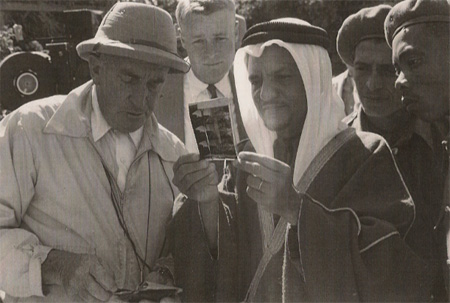 Scene
from filming of "Seven Wonders of the World. Image David Strohmaier. Scene
from filming of "Seven Wonders of the World. Image David Strohmaier.Dec.26, 1954 Due to various and sundry delays, we did not leave Aden until rather late in the day. Our plane trip to the town of Ghuraf, which is in the East Aden Protectorate, and is part of the Wadi (valley) Hadrahmut took us over some of the most desolate country that I have ever seen. The trip only took about two hours and we started flying over the Gulf of Aden which is part of the Red Sea, then we flew inland over a vast brown desert, and then over a vast plateau country dreadfully eroded by centuries of pouring torrents caused by floods during the rainey season. Since there is no vegetation, these flood waters rage uncontrolled over the tops of the plateaus down into the valleys about 700 to 1,000 feet below. The only fertile parts are those in the very center of the valleys where a small portion of the water remains in pools and shallow water holes providing moisture for a few date palm trees and other rugged plants. Although these areas are populated by Bedouins, as the roaming Arabs are called, very little food can be grown, with the exception of dates, some wheat and alfalfa for their goats and lambs. These people do not eat pork and very few cattle are to be seen. Their main source of meat is the goat and lamb. Most other foods such as rice, oats etc. are imported and brought into the country by camel caravans or trucks, but mostly by camels who smell to high heaven when you get close to them. At about 4:30 in the afternoon our plane landed at Ghuraf, which is about 20 miles from the town of Seiun where we are to spend the night. After unloading the plane of camera equipment, no sound, we started by truck and car to Seiun. It was the bumpiest and dustiest ride since the trip from Baghdad to Babylon, previously related and I arrived there with a sore rear. Our arrival in Seiun was in darkness and did not see much of the town except for outlines of the adobe houses. However a most pleasant surprise was in store for us. We were quartered at one of the palaces of the local head man by the name of Said Abdul Bakar. It seems that this man was born in the area and made a fortune trading in Singapore and then returned to his native land to improve the lot of his people. All he seems to have done is to build a lot of mud palaces for himself which are not of much use to anybody and certainly not for the benefit of his constituents. The place had a swimming pool and about 25 or 30 good size rooms with nicely frescoed ceilings but no furniture- here and there a few rugs on the floor. We all slept om cots we brought in after eating a supper of goat meat and dates furnished by said SAID. Dec. 27, 1954 Awoke this morning after a good night's sleep. Toward early morning it got very cold but I was prepared with three blankets on my cot, one on the cot used as a buffer for the cold rising from the floor and two on top. Although the sun burns down on this country all day long from a cloudless sky and heats the desert sand, much of the heat absorbed by the earth is dissipated at night into the atmosphere and it gets very cold, especially in this season of winter. I am not certain, but the reason probably is the lack of vegetation which would tend to absorb and hold the heat of the sun. After a breakfast of ham and beans, we left Seiun by car and truck for a town called SHEBAM, about 20 miles to the west where we are going to film the local atmosphere, mainly some buildings in the town made of mud and straw bricks which appear to be 8 to 12 stories high. An hour or so later we arrived in Shebam just as the women, dressed in black and heavily veiled, and children were drawing water from a series of five wells located just outside the gates of the town. The wells are not very deep and some were almost dry. They draw the water by means of dropping an open skin into the water and hauling it up by hand. The water is then put into a large goatskin by means of a modern tin funnel. The Goatskin is solid and is removed from the carcass of the animal without marring the skin in any manner. The result is whole skin which is tied with leather thongs at the legs and neck with an opening at the rear with a flap where the water can be poured in and out. The average skin holds from six to eight gallons of water and it is very funny to see the women walk away with the skins slung over their shoulders and the tin funnel set at a cocky angle on top of their heads. As the morning wore on it got very hot and we all required something to drink but someone had forgotten to bring the fruit juice we had been drinking or water from Seiun and everyone suffered to some extent from thirst. They also had forgotten to bring food for lunch. When food and drink finally arrived it was about 1:30. This is something that never should happen and would not happen if we had people with us who were familiar with location problems of this nature. During the siesta period I wandered around the town and purchased a few Arabian trinkets- two hand wrought silver bracelets and a very fine curved Arabian dagger with a handle wrought in silver. I was unable to purchase a sheath but will try to do so when I return to Seiun where I am told they make the sheaths. After working until 4 PM or so we all returned to Seiun, arriving there just before dark. We were all hot and tired so after resting a few minutes, all took a dip in the swimming pool and enjoyed a cool refreshing swim. The natives who watched us were amazed that we went into the water at this time of year which is their winter. They all said or indicated that the water was much too cold for them. Their reaction of cold was amazing to us too, as the water felt very warm, the difference probably being to the different condition of our blood to theirs. After a supper of the toughest chicken that I have ever eaten, boiled potatoes, canned vegetables and fruit, we all went to bed. Mike Mahoney went to bed early saying that he had a chill. Dec. 29, 1954 After shooting a few silent scenes in Seiun we plan to leave for the return trip to the air strip and Ghuraf and then by plane to Aden. Before we left, the son of Said Abdul Bakar took me into town to look for a sheath for the dagger (called Jambia) which I had bought yesterday in Seiun. We finally came across an old man who had a very fine silver one which he was willing to sell for a price. I did not have much time, but after a bit of bargaining we settled on a price of 75 East African Shillings and the exchange was made with good will and handshakes all around. At 11:00 AM we retraced the long rough dusty trek to the airstrip and took off for Aden, flying again over the vast desolate country previously described. The ship we were flying had a rough starboard engine which was giving the pilots trouble. After landing I noticed the pilots go to work on the engine and within an hour and a half it had been removed from the ship for replacement. At 4:00 PM the second plane arrived with two sick men aboard, Mike Mahoney who had a high fever and who was taken at once to the R A F hospital in town , and Harry Squire who had badly inflamed eyes. The rest of the crew unloaded the DC3s and we re-loaded equipment and gear aboard the DC4 in preparation for a flight to Bahrain which will occur either tomorrow or the next day, depending upon word from Lowell Thomas who is in Saudi Arabia. | |
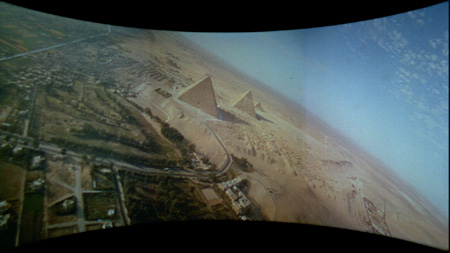 The
Pyramids in CINERAMA. Smileboxed 3-strip Cinerama frame grab supplied by
Dave Strohmaier/Cinerama Inc. The
Pyramids in CINERAMA. Smileboxed 3-strip Cinerama frame grab supplied by
Dave Strohmaier/Cinerama Inc.Dec. 29, 1954 Word has not been received from L.T. so we are spending the day in Aden, resting and conserving energy for the rigors that lie ahead. I did some shopping in town and decided that I would trade my Contessa for a new Rolliflex camera similar to the one I used to have and which made the type of pictures that Mona and the boys like. In addition to my camera it cost me $70. which was a good deal as the Rolleiflex is a very fine instrument. The condition of Harry Squire is much improved but Mike is still in the hospital with a 103 degree fever. The doctors have diagnosed his ailment as “strep” throat and he will have to remain there at least five days. This means that he will not go into Saudi Arabia. Staying with Mike will be Harvey Genkins, a Jewish boy who is working as assistant cameraman, hired in New York. He cannot go into any Arabian countries because of his religion. They knew this in New York at the beginning of the trip and still they took him along. He has been eliminated on trips to Syria, Iran, East and West Aden Protectorates and now Saudi Arabia. While the rest of the men share the load, he waits for us at the next port of call where we can use him- What a stupid arrangement! The director Andrew Marton, is also Jewish and will not be allowed in Saudi Arabia. He will fly with the crew as far as Bahrain and will await us there. Dec. 30, 1954 At 6:AM this morning we left Aden for Bahrain, a distance of 900 Miles. We will either stay in Bahrain overnight or leave at once for Riyadh, the capital city of Saudi Arabia, depending on the news and instructions to be received upon landing. The flight was very dull and uninteresting over hot dry and arid desert. Five and one half hours later we touched down at Bahrain and L.T. was waiting for us at the field. He told us that although he is not going to Riyadh with the crew that all arrangements for shooting had been made and that we should stay there until probably Tuesday. After refuelling the plane took off and about two hours later we arrived at the capital of Saudi Arabia, a country which has just about the richest resource of oil in the world today and a country of vast contrasts which I will attempt to describe later. We were greeted at the airport by King Saud Saud’s secretary as Sheik Abdul, who was very charming. We were all served a peculiar kind of hot herb in a small cup and then a very good ceylon tea. After an hour of pleasant chat we were escorted to our hotel which was quite modern considering that we are in the middle of the great Arabian desert. However, this country due to its riches of oil, is fast becoming westernized, which I will relate later. Dinner was served in the dining room and it was good, consisting of soup, a rice course with meat, a main course of veal, vegetables and potatoes, fruit and tea or coffee. Everyone was tired so after dinner we all went to bed early. | |
|
Dec. 31, 1954 to Jan. 4, 1955 Today we will have an experience that few people, especially Americans, have the opportunity of partaking. For me actually two experiences; one of observing the country of Saudi Arabia from its capital city of Riyadh, and the second of having luncheon as guests of King Saud al Saud, the reigning monarch of most of the peoples of the Arabian peninsular. Saudi Arabia is a country of contrasts – a country of green fields and desert wastes, a country of cadillacs and camels, a country of the electric light and the olive oil lamp, a country of tall palm trees and short scrubby bushes, a country of violent rain floods and long dry periods, a country of the very wealthy and the poverty stricken, a country rapidly becoming westernized and clinging to its ancient customs going back thousands of years, a country of immense wealth of black gold (oil) and little water, a country of gaudy palaces and squalid hovels, a country of concrete buildings and mud and straw huts, a country of education for the rich and illiteracy for the poor, a country of superiority of men and servitude of women, a country of the airplane, model airplane and camel caravans. After filming a scene or two of King Saud in the morning, we were invited to attend a luncheon at one of the King’s palaces near Riyadh. Among the dignitaries were several local Sheiks, military men, wise men and councellers of the King’s court and of course the Cinerama crew. Lunch was served in a large room surrounded by decorative neon lighting. The king was seated at the head of the table which was in the shape of an inverted U, the king being at the base of the U and the guests seated on both sides of the arms of the U. Before luncheon was served the daily news bulletin was read to his majesty so that all could hear. Of course it was read in Arabic. Once in a while we Americans could pick out a familiar name or phrase. The lunch consisted of green pea soup with croutons as a starter, followed by a very good dish of brown rice and chicken, then a meat course consisting of veal, potatoes and vegetables. For dessert we had a dish of lime jello with cream and topped off with fruit and two glasses of milk. The milk was excellent and came from King’s private herd of cattle and was very rich in butter fat content. Apparently it is the Arab custom to eat as quickly as possible, thank your host and depart. Very little conversation was held during the meal and as soon as a food course was finished, no time was lost in serving the next course. As soon as the lunch was finished the King arose and was followed by all of the guests to the outside gardens where he shook hands with all of us and bid us adieu for the time being. On Jan 1st we did some shooting of the king which in my opinion was not very good and doubt that it will make the reel - at least some of the material. The second and third of Jan. turned very cold with lots of rain and it even hailed here in the center of the Arabian desert. I caught a cold here and it has affected my left ear ever since. On Jan. 4, since the king left Riyadh for a hunting trip, to be gone at least two weeks, it was decided to leave Saudi Arabia and return to Aden via Bahrain where we are to meet Walter Thompson. I hear that he practically holds the whole operation at his fingertips. | |
|
Jan. 4, 1955 Last night we arrived in Bahrain again, flying from Riyadh in one and a half hours. Although my cold is still bothering me, I went into town to look at some Persian rugs, which were much too expensive. The last time I was here I remembered seeing a store that had some good ivory figures in it, so went lookin and found the shop. The proprioter was having a 25% discount sale on all items. I bought several ivory figures and animals which should look good at home. After shopping, went back to the BOAC Speed Bird Rest House where we were staying and had supper and went to bed. There was nothing else to do and everyone was tired. Jan 5, 1955 Early this morning the plane, christened in Rome the “Clipper Cinerama” took off from Bahrain for a six hour flight to Aden. The flight as usual was pretty monotonous. Plane travel is only good if one wants to get someplace in a hurry. For me transocean travel is by far the best, by boat where the voyage can be enjoyable and restful. Arrived in Aden about 2:00 PM and learned that Walter Thompson was here with his new wife. He did not meet us at the airport and I did not see him until 9:00 PM when the group was asked to meet him in his room. We were told earlier in the day that all of our fates rested in his hands and expected to hear at the very least, some useful and workable information. However very little was said. He did say 1. That better communications would be established. (Pardon my laughter) 2. That two new directors would enter the picture (which I think is not good policy) one for India and one for Japan. 3. That we would be on locations until the first or 15th of April. 4. That we would probably come home by way of Europe and not fly the Pacific. 5. He invited “gripes”. (I did not fall for that gag. I know him too well) and that was about all. Tomorrow early, we are flying to Nairobi for our third trip to the Belgian Congo in less than four months Jan. 6 to 9, 1955 This morning very early we departed from Aden for an estimated six hour flight to Nairobi arriving there about one o’clock in the afternoon. The altitude of this city in Kenya is over 5,000 feet and the weather was pleasant and cool upon arrival, as compared with the Arabian peninsular. We stayed overnight in the Norfolk Hotel and our director, Andrew Marton, gave the crew a very nice dinner in the New Stanley Hotel grill. The meal was very good. I had smoked Scotch salmon, soup, a beef fillet called Chateaubriand with mushrooms, salad, red and white wines, a peach melba for dessert and coffee. On Jan 7 we flew from Nairobi in Kenya to Usumbura, Ruanda Urundi in the Belgian Congo. The flight was normal and without incident. Arrived in Usumbura, unloaded the equipment from the plane and proceded to the Paquidas Hotel to spend the night. The next day, Jan 8 we all got into cars and trucks for the perilous 4 to 5 hour journey to Astrida. The road was very rough and the descriptions have been covered in my earlier Log made on an earlier journey. Arrived in Astrida and got a good room in the Hotel Foucon which will be a place to rest and eat for the next week or so. On the morning of Jan 9 all equipment was consolidated in the trucks for the journey to Nyanza, about 70 kilometers from Astrida. It is near the town of Nyanza, a place called Kabgayi, where we are going to photograph and record some of the tribal dances of the Watutssi tribe. Each day that we work on this location we will have to make a round trip of 140 kilometers to Astrida. There is no place to stay in Kabgayi. | |
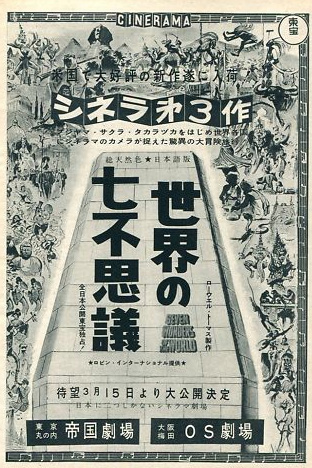 Jan 10, 1955 We arose at 5:30 AM this morning to prepare for our trip to Kabgagi where shooting of the Watutssi sequence is to take place. Kabgagi is a village near the town of Nyanza and just about in the heart of the Belgian Congo. The altitude is about 6500 feet above sea level and although only about 3 degrees north of the equator, the weather is very pleasant, and although hot during the day, the humidity is rather low and altogether a very pleasant climate. The nights that we spent here were clear and cool and we had no difficulty in sleeping, especially after working in the outdoors all day long. Jan 10, 1955 We arose at 5:30 AM this morning to prepare for our trip to Kabgagi where shooting of the Watutssi sequence is to take place. Kabgagi is a village near the town of Nyanza and just about in the heart of the Belgian Congo. The altitude is about 6500 feet above sea level and although only about 3 degrees north of the equator, the weather is very pleasant, and although hot during the day, the humidity is rather low and altogether a very pleasant climate. The nights that we spent here were clear and cool and we had no difficulty in sleeping, especially after working in the outdoors all day long.Our location for shooting the Watutssi sequence is the flat ground in front of the palace of the Queen Mother who is in residence there. During our stay there we did not see her as I understand that she has no liking for Europeans (which she considers us) and further thinks that the present “Wami” (king) is rather light-headed and she does not have much respect for him. The “Wami’s” name is Mutara Rudahigwa, and he is about seven feet tall and said to be one of the shorter members of the tribe, although I did not see any larger men. When we arrived at Shogwe, the Queen Mother’s palace, we saw a low building made of brick, tan in color, completely surrounded by a wall of the same texture and material. The building was not too large, but had two towers on either side and a base resembling European architecture and plan, complete with gasoline engine generator power plant for electricity. I can appreciate Art Buchwald’s comment upon the conclusion of his visit to the Watutssi king. He and his friend decided that the king was not civilized because “there was a fly in the house and besides the champaigne was not cold”. As the morning wore on, the area in the front of the palace began to fill up and the dancers, musicians and drummers arrived in trucks etc. Several hundred natives arrived at the location, all interested in being in the picture and curious as to what was going on. The principal artists in the ceremonies we were to photograph were men of more or less norman stature and some quite small. They carried lances and bows with hunting arrows, and their head dress consisted of some type of hair- it looked like horse-hair, used to simulate a lion’s mane. They wore no clothes except a diagonal strip of cloth across the chest and a loin cloth. Their feet were ringed with a series of bells, hand wrought in the shape of a clam-shell and without anything inside to make them ring. The bell tone is created by one bell hitting against another. The drummers were dressed about the same as the dancers but without the head-dress. They played drums and tom-toms of different sizes and the beat was very effective. The other musicians were those who played a type of pipe made from bamboo, or a gourd of varying sizes and air outlets to give the desired pitch. To me the most interesting spectacle was the natives who come to join in the fun. Many of them were fine-featured and did not to be of negro origin. As I understand the story, the Watutussi came from the vicinity of the Egyptian Nile country some thousands of years ago. They conquered two negro tribes called the --------- and the -------, who became the slaves and servants of the Watutssi, who still rule the Ruanda- Urundi today, under a Belgian Protectorate. Although the Watutssi were the conquering nation, the tribe adopted the language of the conquered and they speak their adopted tongue today. Another example of their Egyptian origin is the type of cattle in evidence in that country today. They are of a long-horn variety shaped somewhat like a crescent. Some of the horns that I have seen were at least five feet from tip to tip. They are not a large or heavy breed but quite graceful with small shoulder humps. During festive occasions the cattle are brought in from the pasture lands and decorated very gaily with all manner of picturesque trappings. The natives of the Congo are very interesting and have a child-like interest in everything that went on. They laugh very easily and for the most part are a friendly and cheerful race. The things that interested them most were glass bottles we used to carry water. For the most part the bottles were empty scotch bottles and when we finished using them, the children women and men would plead for them as gifts with their eyes. When an empty bottle was given to one of them, they would hold out both hands to receive it and thank you in their native tongue. Any item ever given to a native that I have seen would be received with both hands, cupped as if drinking water from them, and to me this was most interesting as compared with our western habit of receiving a gift with one hand. The gesture is rather beautiful and its humility could be copied by the Africans western brothers to show appreciation for so many of the good things in life that we are all too prone to take for granted. As one travels he begins to take fewer and fewer things for granted and starts to appreciate the many things in our life which are so difficult for others to obtain. Jan. 11 to 14, 1955 These days were spent much in the same manner as that of Jan. 10. We continued the Watutussi sequence, traveling back and forth to the location from Astride by car, leaving early every morning and arriving back at the hotel just before dark. Since there was nothing to do after supper, an unusually long time was consumed in eating dinner, and after some pleasant conversation, early to bed. | |
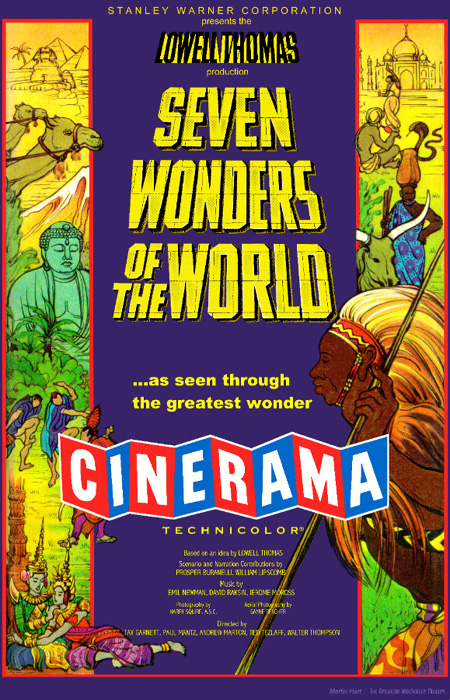 Jan. 15, 1955 Last night after a short flight we arrived in the British colonial town called Entebbe in the East African colony of U-ganda which is a British Protectorate. The town is located in the northern end of a very beautiful lake called Victoria. The hotel we are staying at is called the Lake Victoria Hotel and is one of the nicest places that we have stayed at on this trip. The structure is rectangular in shape with two floor levels and most of the rooms facing on an inner courtyard which is nicely landscaped with flowers and bushes, vines and trees of every description. Across the road is situated the local nine hole golf course, and a short distance beyond, the shoreline of the lake where swimming, though dangerous because of the type of water, is permitted. In the afternoon while the crew was lugging camera equipment to the Uganda National Park, about one hour by air from Entebbe, I laid down on the beach and had a sun bath for about one and one half hours. The view and shoreline reminded me of Hampton Bays Shinnecock Beach on Long Island, New York and while alone I relaxed and enjoyed myself. Jan. 15, 1955 Last night after a short flight we arrived in the British colonial town called Entebbe in the East African colony of U-ganda which is a British Protectorate. The town is located in the northern end of a very beautiful lake called Victoria. The hotel we are staying at is called the Lake Victoria Hotel and is one of the nicest places that we have stayed at on this trip. The structure is rectangular in shape with two floor levels and most of the rooms facing on an inner courtyard which is nicely landscaped with flowers and bushes, vines and trees of every description. Across the road is situated the local nine hole golf course, and a short distance beyond, the shoreline of the lake where swimming, though dangerous because of the type of water, is permitted. In the afternoon while the crew was lugging camera equipment to the Uganda National Park, about one hour by air from Entebbe, I laid down on the beach and had a sun bath for about one and one half hours. The view and shoreline reminded me of Hampton Bays Shinnecock Beach on Long Island, New York and while alone I relaxed and enjoyed myself.In the morning I took a walk around town and although the seat of the government, the place is quite small and there is very little of interest to be seen. I have been told that the town of Kampola, about 20 miles from Entebbe is much more interesting and plan to go there if the opportunity presents itself. The reason that we have come to this country is to photograph the animals that swim in their natural state in the Uganda National Park, Murchisons Falls on the Victoria Nile River. This area is quite wild and desolate about 200 miles from Entebbe in the heart of the “tetra fly” country. All the Photographic work is to be done from a river launch and no sound will be made. The problem of sound in this instance is rather difficult because of the constant “put put” noise of the engine exhaust. The details of transporting equipment to the site are being handeled by the camera crew and I expect to go up tomorrow. Had a very nice lunch and dinner at the hotel and went to bed early. We are to arise at 5 AM for the trip by chartered DC3 and car to Murchisons Falls. Jan 16, 1955 Arose this morning at 5 AM to make the trip outlined in the log on Jan. 15. Had breakfast at the Entebbe Airport and left at 6:30 AM for a point about 40 miles from the location. We flew over a vast area of the country which was being burned off. It seems that this part of Africa is plagued with a fly called “tetse” which is the cause of sleeping sickness if a person is bitten by one of these pests. The body of the person bitten wastes away and the disease is usually fatal. The reason for burning off the plains is in an effort to control this pest which spreads so much havoc among the native population. After a flight of one and one half hours we arrived at a place called Wrangrack Airstrip and from there took off in jeeps for the 40 mile trip to the falls. The route took us over a very rough clay-packed road. Although we did not see any elephants on the way, we knew that they were around in the tall grass about 10 to 12 feet high on either side of the road. The evidence of their presence was large piles of dung as big as bowling balls about every 20 or 30 feet on the road. These deposits almost gave the feeling of what the elephant was thinking, such as “this is the white man’s road, let’s mess all over it”. We arrived at Murchisons Falls and loaded ourselves and the camera equipment aboard a small river launch. After a delay of one half hour the launch proceeded up the Victoria Nile River toward the falls which was about seven or eight miles away. We had not gone more than a quarter of a mile when we came upon a small herd of hippos swimming and playing in the river water. They remained near the surface of the water with only their snouts and ears above the surface and remained in that condition until the launch was 25 or 30 feet distant from them. Then with a loud snort and upheaval of their bodies, they would dive beneath the surface to reappear 15 or 20 seconds later. Our course continued up the river and all along the banks we could see crocodiles, lone bull elephants and small herds with cows and the young ones guarded by a large male. We saw water buck, water buffalo and small groups of baboons all of which were photographed and some excellent pictures were obtained. I took some still photos and 16mm motion pictures which I hope will turn out well. About 12 noon the boat pulled over to the right bank and we all enjoyed a cold lunch of meat, chicken, salad, bread, cake and iced tea. After lunch it was thought that we would proceed further up the river to make a shot of the falls but the captain said that the idea was too dangerous because of difficulties of navigation. If the boat were wrecked we would not have much chance of getting to shore, what with crocodiles, hippos, snakes and various forms of man eating fish, which although very small can pick a body clean because of their sharp teeth and the fact that they attack in schools. It was decided not to take the risk. During the trip back to the landing we came upon several herds of hippos who all went beneath the surface when we came within a short distance of them. One big bull hippo dove and came up under the boat almost tipping it. He was so frightened that he dove again and in doing so, broke a chunk of wood off the bow, about a foot and a half long and 1 1/2 inches wide. | |
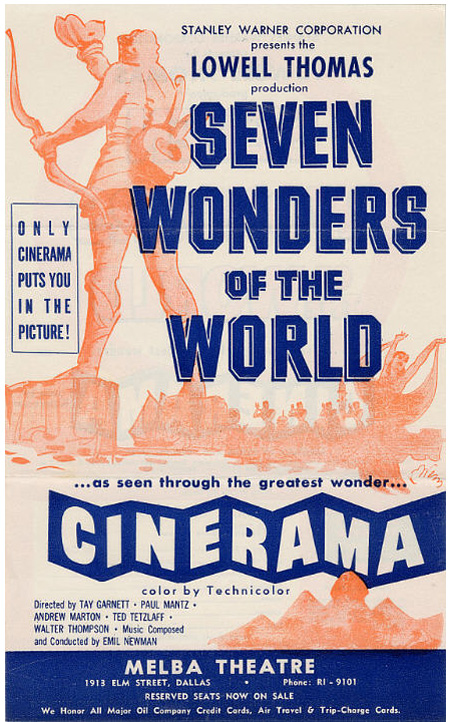 Jan 17 to Jan 25, 1955 This time was spent in traveling over pretty much the same territory that we have been to before; i.e. Nairobi, Aden Bahrain etc. Jan 17 to Jan 25, 1955 This time was spent in traveling over pretty much the same territory that we have been to before; i.e. Nairobi, Aden Bahrain etc.Jan 26, 1955 Today is the day celebrating the birth of the Republic of India. With very poorly made arrangements on the part of the “Production Staff” we went in convoy to the so-called India Gate where the camera and sound were to be set up. The camera had been given permission for its allotted position but no permission had been secured for the sound. Under the circumstances I did the best that I could do to get wild sound track to match with the picture. Actually the only spectacular part of the demonstration or parade, which consisted of a show of military strength, were four Indian elephants decorated in the familiar trappings of those ceremonial elephants seen in India. By 11:30 AM the entire parade had passed our point of vantage in front of the esplanade leading to the governmental palaces and buildings. Although it has been raining in New Delhi since our arrival, today was cool and clear. The appearance of good weather brought out thousands of the population, but there was nowhere near the 750,000 that I was told would watch the passing of the procession. By 1:00 PM we were back at the Maiden Hotel having lunch and taking things easy. Jan 27 to 28, 1955 These two days were spent pretty much as we had done on Jan 26. We had an opportunity of visiting one or two temples in the city and vicinity of New Delhi, one of which combined a place of worship for Hindus and a very fine garden and playground for children and beautiful gardens for the adults. The structure was rather recent, being only 20 years old. The other we visited was about 11 miles from the city and built about 700 years ago when this part of India was under the rule of the Islamic peoples from the Arabian countries whose culture was centered 1500 miles to the west. New Delhi and old Delhi lie side by side and have a combined population of about 2,500,000 people consisting of people who rule the country of India, merchants, beggars, gypsies, human beasts of burden and more than 1,000 lepers who are free to mingle with the rest of the population. The day of our arrival in New Delhi there was an article in the newspaper telling of the alarming increase of leprosy and that the government was trying to take steps for segration. The lepers exist by begging from tourists during the day, securing about 6 to 10 rupies (rupee= 21 cents) and then leaving the city for the night to return again the next day. Merchants are strewn about the city in all manner of huts and buildings. They deal in tailor-made clothing, food, fuel, brass tin and copper ware, jewelry, rugs, precious and semi-precious stones, hand-woven cloth from Madras, Kashmir and Bahnaras. The woven cloth is especially beautiful done on pure silk with silver and gold threads and silk threads dyed with vegetable colors. I purchased a Bahnaras scarf or stoll for Mona made of black silk and Hand-woven with silver, gold and colored silk threads. During the day there are people in the streets by the thousands, mostly men, who carry on their trade as it may be, or do porter or manual work, or drive carts pulled by bullocks, or bicycle type rickshaws; all busily progressing from one point to another. In the streets are hundreds of sacred cows which are allowed to wander at will through the maze of narrow and densley populated streets. The cows are sacred to the Hindus and one must do them no harm. The flies are here by the millions on the people, in their sores in their eyes and mouths, on food which is left in the shops completely uncovered. They thrive on the dirt and filth which is left to accumulate in the streets. The streets are also crowded with scavenger dogs and birds which help to clear the city of some of its filth. They say that New Delhi is one of the cleaner cities in India, so I am wondering what the others must be like. Jan 29, 1955 Today we left for Dhahran in Saudi via Karachi where we are to pick up John Farrow, the director of the Saudi Arabia sequence and his assistant, a fellow by the name of Emmet Emerson. Upon our arrival we found that we had good hotel accommodations, transportation and three good trucks, all arranged for by Emerson. This is the first time that details like this have been so well prepared for on this trip. Jan. 30, 1955 to Feb. 15, 1955 This two week period was spent in re-tracing our steps in Dharan and Riyadh in Saudi Arabia. There was very little to note of interest as most of the ground had been covered before. On Feb 14 we did some work with the Sheik of Bahenin and upon leaving his kingdom he presented each member of the crew with a camel cloth desert cloak and a hand embroidered shawl to be worn as a head covering. The gift was very nice and much appreciated by all recipients. Feb. 16, 1955 Today we left New Delhi for the holy city of Banaras, about 400 miles by air and located on the Ganges River. Arrived at about 12 o’clock and were settled in a good hotel called Clarks where a pretty fair lunch and dinner were served and all went to bed early as we were tired. Feb. 17 to Feb. 26, 1955 Upon our arrival in Benaras we were greeted and welcomed by Tay Garnett who is the director assigned to do the sequence here. He took Squire (cameraman) and myself (sound) out the afternoon of our arrival and gave us a complete tour of the locations to be done, together with a description of what he wanted done. Upon our return to the hotel he gave me a copy of the shooting script which had been prepared. For the first time since director Marton worked with us (he returned to the States about Jan 22) we appeared to have a close working unit in the interests of good production shooting. However it was too good to be true. The night that we returned from location scouting, Garnett called Squire and me into his room and explained that because of illness he had to send his assistant home and although he had requested a man to take his place, Walter Thompson in New Delhi refused to take any action. There were probably other disagreements that entered into the picture, but Garnett did not go into further detail. He did say that he felt that the director should be in supreme command on his location unit and would not tolerate any interference. The result of this personal and political conflict was that the crew waited around the hotel for four days awaiting the outcome. On Sunday Feb. 20, the director and his wife left Benaras on his first stage of the return to California. He previously had cabled Merian Cooper in Hollywood for a clarification of the point and received no answer. Just as he was about to board the plane a copy of a cable from Cooper was handed to him wherein Cooper stated that he (Garnett) was in supreme command for his sequence in the field and in interests of the picture, shooting etc was to be resumed at once. Garnett returned to the Hotel and said that we would go to work the next morning. | |
 Log of "Seven Wonders" Production for Lowell Thomas Production Log of "Seven Wonders" Production for Lowell Thomas ProductionFeb 21 to Feb. 21 We completed the sequence in Benaras, some scenes with sound and some without. The city of Benaras is located on the Ganges River and is about 400 miles south of New Delhi. The city is a holy one and many pilgrims of the hindu religion come each year to bathe in the river and thus cleanse themselves of all sin. A motor launch trip along the river reveals that Benaras is wholly built on the west bank of the river. The east bank mainly contains sandbanks and some cultivated areas some few mud and straw huts. Of course the west bank is the most interesting. Starting from the Raj Ghat (steps) we proceed north up the river in the early morning. There are thousands of people bathing, scrubbing themselves, washing their teeth, washing their clothes, praying and drinking the water. The men wear loin cloths and the women immerse themselves and then remove their Darees, ( a garment which is about six yards long by a yard wide and dyed a single color such as red, yellow, orange etc.) bathe and put the saree on again before exposing themselves. Both sexes appear to be very modest, at least in public. The Hindu art of making love, “Kama-Sutra” is another story from what I have read. As the launch goes up the river we pass great piles of fire-wood, boats of odd design filled with sand, straw and other articles of commerce etc. We also passed many ghats (steps) that contain temples and thousands of people selling food and wares to the local population and pilgrims. Beggars by the score are everywhere; little girls carrying half-dead babies in their arms pull on your jacket, show you the pitiful skeleton and ask for money (Bak-sheesh). Then too there are lepers who also beg for a living and it is a nasty sight seeing them with out-stretched arms and legs containing stumps for fingers and toes imploring with sightless eyes for your money. The Hindu sects making the pilgrimage to Benaras believe in cremation as a means of disposing of their dead. This is done on the bank of the river at a place called the Burning Ghat. Here dead bodies are brought by boat and cart to be placed upon a bed of 4 large logs. Over the body are placed 4 more logs of the same size. The torch is applied to the logs and the body consumed. The ashes are then collected in a pile and taken out to the center of the river and dumped. Some families do not have enough money to pay for logs to consume the entire corpse. In this case they burn the body to some extent then wrap cloth around it and throw it into the river. Sooner or later the vultures and crocodiles finish the scavanging job and that is the end of Uncle John or Auntie Agnes. One morning I saw four such corpses in the river and atop each were the vultures pecking away. So much for that. Feb 27, 1955 Today the crew left Benaras for Agra which is halfway between that city and New Delhi. Agra is the city where the Taj Mahal is located and we are to do a short sequence of the Taj which will take a day or two. When we arrived I had heard that Walter Thompson was to come tomorrow or the next day from New Delhi for a conference with Tay Garnett. When he arrives, Fred and I plan to talk with him and put in a request for more money. Since Rome the job of handling sound and electrical equipment has settled down on the sound crew. We originally had a four man sound crew and one electrician. Since Cairo and Rome the sound crew has been reduced to Bosch and myself and only recently has Marshall returned (a former sound man) to take care of the electrical dept. and generator. | |
| Letters Sent Home - supplement to log of "Seven Wonders of the World" | |
| Go: back - top - back issues - news index Updated 21-01-24 |
